

UK EDITION · ISSUE 54 · 2023 · FREE COPY

advantage of our online Portal, order what you want, from wherever you are. relax, we got you covered
Take

download our catalogue at highlighthorticulture.co.uk (0)1949 839 727 sales@highlighthorticulture.co.uk









Unlock the full potential of your plants with Bio·Heaven!

Helps your plants absorb more nutrients available in the substrate and metabolize them efficiently.
Increases both the quantity and the properties of the final yield. Is a source of free amino acids and active components that allow us to see notable effects in little time.
Keep it organic! Keep it Biobizz!


















7 CONTENTS IN THIS ISSUE OF GARDEN CULTURE : 11 Foreword 13 Author Spotlight 14 Marketplace 20 Confessions of a UK Hydro Store 22 LED to Stress? 24 The Importance of Temperature Control 30 The Ocean’s Power To Heal 34 The Potential of Seaweed Extracts in Hydroponics 36 Community Supported Fisheries: Local Fish To Fork 38 The Benefits of Using Shade Cloth 46 New Technology, Research and Development, and What’s Next for Farming 48 Building Your Garden to Handle Climate Disasters: Gardening for Wildlife 54 Good Vibes - What’s Farming Without Friends? 58 A Grower’s Guide To Using Humic Acids 64 Psychometrics,Vapour Pressure and the Seemingly Never-Ending Chase for Your Setpoint 66 Garden Travels - Quebec’s Reford Gardens Are Good For The Soul 72 Staggering Mushroom Harvests 74 Returning to the Well - An Elemental Approach to Good Living in Mushroom Cultivation 78 Gardens and the Chlorine Conundrum 80 Building An East Coast Champion Tree Archive 85 A Place For Connection 88 Passive Solar Geothermal Greenhouse at the 45th Parallel 92 Local Growers 96 5 Cool Ways 92 LOCAL GROWERS 48 14 MARKETpLACE BUILDING AN EAST COAST CHAMPION TREE ARCHIVE 80 PASSIVE SOLAR GEOTHERMAL GREENHOUSE AT THE 45TH PARALLEL 88 BUILDING YOUR GARDEN TO HANDLE CLIMATE DISASTERS: GARDENING FOR WILDLIFE 22




Available from
FOREWORD CREDITS
Being in control of your garden can be challenging. Outdoor growing is subject to the elements and changing weather patterns. Extreme weather can wreak havoc on your plants; protecting them can sometimes be impossible. When growing indoors, you are ultimately in complete control. Or at least you should be.
Things can go wrong, even when you have all the equipment running like clockwork. I recently bumped into my timer and added 30 minutes of light to my night cycle. Luckily, I have equipment that measures and logs data such as temperature, humidity, VPD, and light levels. I could see the blip of light on when it shouldn’t have been. I might have never caught it if it wasn’t for my NIWA controller. I also use AirComfort, a similar product that measures and logs the same data. These two products are affordable and easily integrated, allowing you to know what is happening in your room and send a notification if something is off.
Indoor growers rely on technology to help them create the perfect environment. Adam Clarke, our HVAC guru, gives his take on VPD in “Psychometrics, Vapour Pressure and the Seemingly Never-Ending Chase for your Setpoint.” Rich Hamilton breaks down the best temperatures for each stage of a plant’s life in “The Importance of Temperature Control.” If you are new to LEDs or still trying to figure out what environmental and nutritional needs your garden has compared to HPS, check out “LED to Stress” by Everest Fernandez.
While many extra factors come into play when growing outdoors, a couple of our writers have taken the bull by the horns to ensure their gardens make it to harvest. In “The Benefits of Using Shade Cloth on Yield and Quality of Vegetable Harvests”, Anne Gibson writes about protecting her plants from the blistering heat. In “ Passive Solar Geothermal Greenhouse at the 45th Parallel”, Marci Babineau explains how her backyard venture has led to better self-sustainability throughout a cold Canadian winter.
If your grow room requires a technical upgrade, why wait? Visit your local hydro shop and get that new LED, controller, pH meter, or silica. You may pick up some pointers from experienced gardeners at the same time!
Happy Gardening, Eric 3
SPECIAL THANKS TO:
Adam Clarke, Alan Creedon, Anne Gibson, Catherine Sherriffs, Cosmic Knot, Everest Fernandez, Jennifer Cole, Judy Nauseef, Keaton Haines, Marci Babineau, Martyna Król, Rich Hamilton, William Texier, Xavi Kief, and the crew at NPK Horticulture.
PRESIDENT Eric Coulombe eric@gardenculturemagazine.com
+1-514-233-1539
EXECUTIVE EDITOR
Celia Sayers celia@gardenculturemagazine.com
+1-514-754-1539
EDITOR Catherine Sherriffs cat@gardenculturemagazine.com
DESIGN Job Hugenholtz job@gardenculturemagazine.com
DIGITAL & SOCIAL MARKETING social@gardenculturemagazine.com


ADVERTISING ads@gardenculturemagazine.com
PUBLISHER
325 Media INC
44 Hyde Rd., Mille-Isles QC, Canada J0R 1A0 GardenCultureMagazine.com
ISSN 2562-3540 (Print)


ISSN 2562-3559 (Online)
Garden Culture is published six times a year, both in print and online.

@GardenCulture @GardenCulture @GardenCultureMagazine @Garden_Culture
DISTRIBUTION PARTNERS
• Creation Wholesale
• One Love Inc
© 325 Media
• Highlight Horticultur e
• IKON
All rights reserved. No part of this publication may be reproduced, stored in a retrieval system or transmitted in any form or by any means, electronic, electrostatic, magnetic tape, mechanical, photocopying or otherwise, without prior permission in writing from 325 Media Inc.


11 GARDENCULTUREMAGAZINE.COM
FOREWORD & CREDITS
Stimulates root system development



B’cuzz Root Stimulator ensures strong roots for optimal absorption and transport of water and nutrients. The more roots, the more connection with the soil a plant has to store and/or transport all the nutrients from the soil to the rest of the plant.





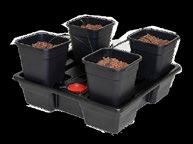


 Wilma Small Wide 8 11L
Wilma Small Wide 8 11l
Wilma XXL 5 25L
Wilma Large 4 11L
Wilma Large 4 18L
Wilma XXL 8 18L
Wilma XXL16 11L
Wilma Mini 8 1.65L
Wilma XXL 20 6.5L
Wilma XL 4 25L
Wilma Small Wide 8 11L
Wilma Small Wide 8 11l
Wilma XXL 5 25L
Wilma Large 4 11L
Wilma Large 4 18L
Wilma XXL 8 18L
Wilma XXL16 11L
Wilma Mini 8 1.65L
Wilma XXL 20 6.5L
Wilma XL 4 25L
@atami.uk
BY
Author Spotlight
Marci Babineau
We’re shining the spotlight on one of Garden Culture’s newest contributors!
Marci Babineau brings a wealth of organic gardening and landscaping knowledge to our pages. She grew up surrounded by nature and is currently building a food forest at her home in the beautiful Laurentian mountains. In addition to starting the Incredible Edible project in Montreal, QC, several years ago, Marci has written about and taught many gardening techniques in her home province and Cambridge, UK. Between these many accomplishments and her incredible journey setting up a geothermal greenhouse at her home, we proudly welcome her to our team!
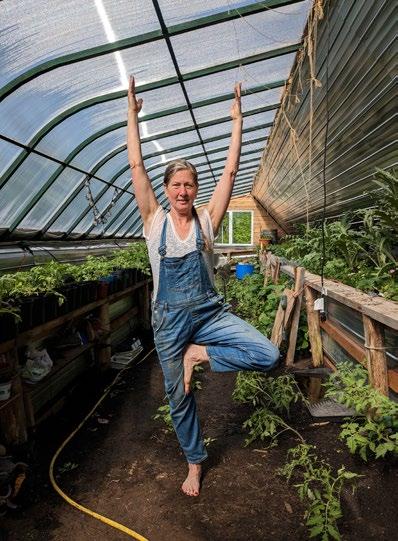
What is your growing motto?
I’m not a motto person, but the other day, I was reminded that we would all be better off growing food from our own soil. Then, the words “Eat your own dirt” came into my head.
What is your favourite plant to grow?
There are so many that satisfy! For instance, cabbages, when they develop that dense sweet head of food surrounded by ruffly leaves, who can resist? However, my top favourite is artichoke. It is a gorgeous perennial plant (points) of which you eat the flower.
Do you have any fun projects on the go?
For the last five years, I have been developing a forest garden with fruit and nut trees and loads of berries. With all of the rain this summer, the food trees and plants have taken their places, and the garden’s framework has come into view.
What is your favourite food?
This is an unfair question, so I will say ice cream since I have just finished some.
Where in the world would you like to travel next?
This winter, I will go to California for the first time in 20 years. It is where I grew up, and I long for the Pacific. 3
Are you interested in writing for Garden Culture Magazine?
We’d love to hear from you! Send us an email introducing yourself with a sample of your work editor@gardenculturemagazine.com
AUTHOR SPOTLIGHT 13
Marci Babineau brings a wealth of organic gardening and landscaping knowledge to our pages
Advanced
Nutrient’s OG Organics
A Complete Growing System For Organic Cultivators
Deliver a robust range of essential nutrients and beneficial elements to your crops, from premium compost teas and soil amendments to the industry’s top-selling bloom booster — in organic form.
With Advanced Nutrient’s OG OrganicsTM base Iguana Juice® Grow & Bloom and a full line of additives, commit to sustainable practices while cultivating a thriving organic crop. These high-quality organic inputs are packed with a wide range of easily absorbable nutrition.
Visit AdvancedNutrients.com to discover the whole line now!
Introducing Coco and Coir SKRAM
An Award-Winning Range Of Natural Coconut Coir Products

Crafted from 100% coconut coir, it boosts plant vitality with exceptional water retention and aeration for robust roots and optimal nutrient absorption.
With low Electrical Conductivity (EC), nutrient control is a breeze. The 75L pack offers both quantity and portability. High quality, sustainable, 100% natural, vegan, pathogen-free, and Soil Association Certified. Coco and Coir now available from Creation Wholesale.


Visit CocoandCoir.com to learn more about the entire range.

The Ultimate Pest Prevention
SKRAM
long-lasting control of pest populations, mak ing it an IPM, ICM, and biological control programmes. It enhances the shelf life of harvested crops, has no residual activity, and is safe for use on all edible crops and ornamental plants. Moreover, it degrades rapidly in the environ ment. SKRAM as an antifeedant and booster plant wash, increasing nutrient bioavailability and plant growth rates while aiding photosynthesis and maintaining plant health.
Dilute 16ml per litre of water. Available in four sizes: 100ml, 250ml, 1 litre, and 5 litres.
For more information, visit maven.earth/skram-info

Preserve Aromatic Plants
TerpLoc® 1-Pound zippered pouches are designed to maintain weight, prevent mould, and preserve delicate terpene profiles while eliminating the need to “burp” containers during curing. Once your product is sealed inside, unwanted gasses and water vapour are diffused through the pouch’s layers. This creates a microclimate with a relative humidity level of 58-62%, limiting oxidation and preventing damage from harmful UV rays.
Ask for TerpLoc® at your local store.
14
GC MaxiLED Strips.indd 1 11/05/2023 10:45

Cocos Premium
100% COCO Substrate


Plagron’s Cocos Premium is a fully buffered coconut substrate with a stable pH value. Suitable for fast-growing plants, Cocos Premium meets the highest quality standards. A low EC value is guaranteed, preventing fertiliser burn. Cocos Premium also has excellent water retention and is free of sand, weeds and pathogens. Plagron coco substrates are clean and pure and can be used safely without risk to your grow.

Visit Plagron.com more info.
Introducing
Airfan FOAM Box Fans
FOAM Box Fans are a lighter, quieter, and highly efficient alternative to traditional box fans.These fans feature thermal insulation and vibration dampening for a quieter and more peaceful environment.They can endure extreme temperatures ranging from -40°C to 110°C, making them versatile for various settings.
Waterproof, fire-resistant, and chemically resistant, Airfan FOAM Box Fans are suitable for indoor and outuse. Choose from different amperage options to meet your airflow needs. Plus, they are environmentally friendly and recyclable. Upgrade your cooling experience today with Airfan FOAM Box Fans, where efficiency meets durability and adaptability, delivering top-notch performance in a sleek, compact design.
@highlighthorticulture for the latest grow gear.
MotherNature CO₂ Refills

are the eco-friendly, long-life, money-saving solution to recharging your MotherNature CO2 Generator. CO2 Refills are packed ‘dry’ for easy storage without fearing degradation or nuisance odours. Depending on usage, your Generator’s specially formulated compost and natural bacteria will last up to six months. Once the contents of the Generator are depleted, you can empty it, clean it down, drop in a Refill, and activate it with some hot water.

Available in 5 L and 10 L sizes, Refills save around 33% against the cost of buying a whole new Generator, and by reusing your existing hardware, you’re also doing your bit for sustainable growing.
Be sure to visit AutoPot.co.uk for more information.

Introducing GOD - Genuine Odour Destroyer, the ULTIMATE solution for banishing unwanted odours.


With four fragrances across the range, including Fresh Linen, Bubble Gum, Lemon Sherbet, and the luxurious Allure (reminiscent of Creed), GOD offers a scent for every preference!
The odour-neutralising gels are available in three convenient sizes: 1 litre, 5 litres and 22 litres, ensuring you have the perfect option for spaces of any scale.The POWER to banish odours is just a spray or gel away!
Ask for it at your local store and follow gardening products.
Discover Biobizz Bio·Heaven

Maximise your plant’s potential with Bio·Heaven, a metabolic stimulator providing abundance, taste and incredible aromas. Bio·Heaven is an organic booster that supports crops during their most challenging stages. Its carefully formulated composition makes it particularly effective during delicate or high-intensity moments. This product contains Free Amino Acids (FAAs), the building blocks of proteins. These amino acids can exist independently or bond to form peptides and proteins.
Additionally, Bio·Heaven stimulates the production of enzymes and accelerates the synthesis of amino acids, fostering a continuous micro-life cycle that is essential during periods of rapid growth and flowering this booster quickly become apparent and can often be observed within just two days. Other organic components help improve the transit of nutrients by facilitating sunlight absorption and photosynthesis, further stimulating the plant.
Are you ready to destroy odours with the power of GOD?
WILMA XXL 8 COMPLETE 18L 45.3” x 45.3” x 7.9” · 115cm x 115cm x 20cm
The Wilma systems offer complete growing systems for every type of grower!

Wilma XXL 8 has a tank capacity of 150 L and comes equipped with 18 L Atami pots, an irrigation system, and a pump.
The automatic irrigation of Wilma Grow Systems allows you to achieve a perfect water/nutrient ratio for your plants to perform optimally.Tedious manual watering is no longer necessary.
Lightweight and easy to transport, along with its stable design, this system allows easy placement wherever you desire.
Terra Aquatica Fulvic
Give your plants a boost with a high-quality fulvic acid. TA analysed and tested many different leonardite sources from around the world to produce a proprietary, pH-balanced fulvic acid with maximum agronomic benefits:
• better root development,
• earlier harvests,
• healthier, disease-resistant plants,
• enhanced quality of flavour and fragrance,
• increased essential oil production,
• significantly higher yields.

• No matter what concentration a product claims, the quality and composition of the fulvic acid counts –and this is why Fulvic outperforms the competition.


Check out TerraAquatica.com for more info.
From the UK’s #1 for 6 Consecutive Years
Remmers Pompen Submersible Water Pumps

Discover a high-performance submersible water pump, the ultimate solution for efficient water transfer tasks. If you need to move water quickly from point A to B, this pump delivers unparalleled reliability and power. It is submersible and adaptable for various applications and ensures a consistent flow rate. Crafted with precision, it’s built to withstand demanding conditions. Plus, its multiple outlet sizes simplify connections to your setup.
With immersion depths ranging from 5.5 to 9 metres, this pump is your trusted partner for swift and efficient water management, the go-to solution for professionals who demand nothing but the best.
Pumps and accessories are available from Highlight Horticulture, or check out your local grow store.
Available in White or Mylar. 18m2 of growing space. Equipped with eight doors and 28 port options in four sizes, eight micro-mesh passive vents, and five nightvision windows, the HUGE PRO Titan 6 Grow Tent is adaptable to all growing needs. It is built to last with a 25mm powder-coated tempered steel frame with practical metal push/click connectors. The double cuff vents are 20% oversized for acoustic ducting. The uplift irrigation bar is ideal for gravity-fed water and nutrient systems. The canvas completely unzips for easy assembly. Silicone roof bar pads reduce vibrations, main door clips, water tray, double stitched seams, and a canvas that completely unzips for easy assembly; the HUGE PRO has every detail worked out to maximise your grow space.
BudBox PRO. Where the PROs grow.

18
BudBox
600x300x220cm
HUGE PRO Titan 6 Grow Tent
/ 19’8”x9’10”x7’4’’









































imitated, never equalled canna-uk.com/boost
Often
PHOTOS: INSTAGRAM NPK TECHNOLOGY




Confessions of a UK Hydro Store Confessions of a UK Hydro Store


Whether you like to grow plants indoors or outdoors, there’s something for everyone at NPK Technology. Located on the edge of Liverpool’s city centre, this innovative hydro shop offers a wide range of horticulture products. But what sets them apart from other stores is their expert advice that comes at no extra cost! We found NPK’s Stephen Brookes in the confession booth for this edition’s hydro shop spotlight.
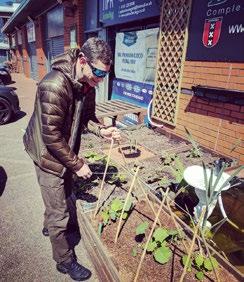
#gardenculturemagazine #confessionsofaukhydrostore #gardenculturemagazine #confessionsofaukhydrostore
20
How did you end up at NPK?

In 2012, I was doing a Masters in Public Health Nutrition and setting up my own supplement business. Thomas and I knew each other from university, where we studied outdoor education and PE. Thomas is an exPara, great at practical work, and helped me a lot; I helped him on the academic side. We became good friends, and when Thomas finished school, he set up the shop and invited me to help him build the business with multiple shops, podcasts and YouTube channels.
What do you like the most about your job?
Science and botany have always intrigued me. Having a background in public health, I was fascinated by how the vast majority of our modern-day medications are derived from plants. Manipulating growing methods, styles, and techniques to achieve better yields, quality and aromas has always been the most interesting part of growing indoors for me. The best part about working in the shop is passing and sharing this knowledge with likeminded individuals.
The past year has been slow. What has NPK done to keep customers coming back?

The same thing we have done since day one. We don’t compete exclusively on price; we provide the best customer service and can help anyone at any experience level become a better grower. Sometimes, we send people out without products because we can solve their problems with advice, and a product isn’t needed. That breeds loyalty, and they’ll always come back to us regardless of price or promotions other people are running.
What is your preferred growing style?
DWC, without a doubt. The ability to manipulate plant growth and flowering appeals to me. Whether oxygen levels, water temps, or root pruning, it’s all achievable with DWC.
How do you handle a customer who tries to negotiate unreasonably low prices?
“There’s another shop on Google Maps; don’t let the door hit you on the way out.” When the shocked face looks back at me, I explain we don’t just sell products for as cheap as possible; we offer a service and a knowledge base that will allow them to get the absolute best from that product, and we don’t sell cheap advice. They usually pay the price ;)
Do you have a favourite product?
Optic Foliar Overgrow is a favourite because it’s one of the first products you could spray with the lights on. Unbelievable! Azos and Dynomyco for potting up are brilliant. SANlight LEDs have always been my favourite because of the product and the team of lovely people! Enviro Controller, because it’s just bomb-proof and controls your room to such precise levels. These are just a few fantastic products off the top of my head.
What is the most common misconception amongst your customers?
Yellow leaves are a nutrient deficiency and not because they are overwatered.
If you could change one thing in the industry, what would it be?
The social media bravado. Many nasty comments can be left on social media, and there’s no need for it. We’re all trying to do what we love, earn money, and get on. I see people trying to bring others down when we should all try and do our best. Build the biggest building in town; don’t destroy everyone else’s to make yours seem the biggest!
What are the top three bands that play in the shop?
• Fleetwood Mac
• Ben Howard (I know it’s not a band)
• Electric Light Orchestra
What top advice would you give someone thinking about starting a small indoor grow room?
Trial and error. Read, listen and implement advice, but most importantly, enjoy taking a seed the size of your fingernail and cultivating it into an absolute monster that can feed you. 3
Science and botany have always intrigued me. Having a background in public health, I was fascinated by how the vast majority of our modern-day medications are derived from plants.
Figure 1
Want to be the next Hydro Store to ‘confess’? Take a picture of this edition of Garden Culture Magazine in your shop, post to Instagram and tag @gardenculturemagazine. OR Send your info to social@gardenculturemagazine.com 21 UK HYDRO STORE

22 BY EVEREST FERNANDEZ
Everest Fernandez
shares some timely advice for LED growers.
HPS lamps emit significantly more radiant heat than LED lighting
The most common advice to indoor growers transitioning from HPS to LEDs is to increase air temperature to ‘counteract’ the lack of radiant heat (infrared) produced by LEDs. HPS lamps emit significantly more radiant heat than LED lighting. Upwards of 40% of the output of HPS lamps is classified as near-infrared radiation (NIR, 700 – 3000 nm).

The key metric here—for HPS and LED growers alike—is leaf temperature. The NIR content of HPS lamps contributes significantly to leaf temperature—especially around the canopy. LED growers aim to run their rooms at higher daytime temperatures (82 – 84°F / 28 – 29°C instead of 75 – 79°F / 25 - 26°C) to make up for the ‘shortfall’ in infrared radiation. However, increasing air temperature can have several ‘knock-on’ effects that must be considered.
Warmer nutrients: If your nutrient reservoir is in your grow room, your nutrient solution is prone to getting warmer in an LED room. This can lead to plummeting dissolved oxygen levels. You may need to use a chiller or locate your reservoir adjacent to your grow room. However, this is not always practical. Always use an air pump and air stone, especially ten or 20 minutes before irrigation.
Quicker wet/dry cycles: Warmer air temperatures will lead to warmer root zones, and fabric pots will be subject to more evaporation. Growers may need to irrigate more often, especially when using Rockwool blocks or smaller-sized containers to prevent salt build-up. Try to achieve 20% runoff; this might not happen during the first irrigation of the day, but it should occur during the others.
Stem Elongation: Warmer air temperatures heat the whole plant, not just the canopy. This can lead to stem elongation and lankier plants that are difficult to manage and illuminate
efficiently. Use a blue-rich full spectrum during the vegetative and transition periods and pruning and training techniques to keep plants low, wide, and squat with many flowering sites at the same height.
High Humidity and CO2 Depletion: LED growers with ventilated rooms can find themselves between a rock and a hard place during the cooler months. Dial down extraction fans to maintain higher air temperatures and risk high relative humidity and low CO2 levels. Increase air exchange to fix those problems and remove precious heat. Invest in a quality dehumidifier, ideally plumbed directly to a drain point and a CO2 generator bucket.
Nutrient Toxicity: No wonder many Instagram soilless growers perform a pre-harvest ‘strip’ before reaching for their smartphone—it hides all the symptoms of salt build-up in the root zone! Don’t automatically increase your nutrient solution concentration when starting with LEDs. Keep a close eye on the EC / TDS of your run-off and compare it with your feed solution. Never let your run-off rise more than 25% higher than your input. 3
Everest Fernandez is a well-respected industry educator, veteran hydroponic grower and grow light enthusiast, based in France. He works primarily as a marketing and cultivation consultant and was the founding editor of Urban Garden Magazine in the UK, US and Canada. He also writes and researches for the popular hobby horticulturalist YouTube channel, Just4Growers.
2323
LED growers with ventilated rooms can find themselves between a rock and a hard place during the cooler months
LED LIGHTING
Bio
The Importance of Temperature
Temperature
24
BY RICH HAMILTON
Getting the best output from an indoor garden depends on many factors, including lighting, water, nutrients, and, most importantly, temperature and humidity.
Temperature and humidity influence growth levels and the overall health of plants. For example, when temperatures are too high, plants in grow rooms are susceptible to root rot, nutrient burn, pest infestations, powdery mildew, wilting and stretching. On the other hand, low temperatures will also hinder plants; they may die from shock, have reduced yields, or develop mould infestations.

Each stage of plant growth has unique environmental requirements. Plants in the seedling stage require different temperature and humidity levels from the vegetative or flowering stage.
Germination
Most seeds germinate at room temperature, but some growers use heat mats underneath starting trays. The mats are beneficial when growing plant species like rosemary, which like it hot. Most seeds germinate at temperatures between 60-80°F (1526°C); depending on the species, the humidity levels must be between 7090%. Heat mats radiate warmth into the tray and growing medium to achieve faster, better germination rates.
Heat mats may never be required if the seed starting room has consistent temperatures around 70°F (21°C) without drafts. Always use a thermostat attachment or a timer when using heat mats for extra warmth. Without control, some heat mats can get too hot, drying out the growing medium and wiping out any emerging seedlings.
Propagation, Seedlings and Clones
Humidity domes and propagators are excellent for raising humidity levels. Many growers use them to help seedlings and clones develop roots. However, do not allow the humidity level to rise above 80%. Doing so can lead to mould and mildew problems and may cause plants to root slower. If the humidity is too low, try regularly misting seedlings or clones with water to increase levels. The general humidity range, dependent on plant species, is 75-85%.
Air cannot circulate efficiently in propagators, so do not keep plants in them too long. Once the plants are big enough, start acclimatising them to life outside the propagator in preparation for the vegetative stage.
Keep young plants at an adequate distance from grow lights to avoid overheating and burning. If using HID lighting, keep the seedlings at least 50 cm from the bulb. Compact fluorescent lamps require a space of about 15 cm from the top of plants. Only a few centimetres of space is needed under regular fluorescent tubes; with LED lights, the distance should be about 30 cm.
Unlike seedlings, clones do not have root systems at this point, so they need to get all their water via the transpiration of the leaves. High humidity levels and stable temperatures are crucial for clones. Root formation and growth rate are fastest when the temperature is in the range of 70-85°F (20-30°C), dependent on species.
Vegetative Stage
“Veg” is when plants grow structurally and put on bulk with their leaves and branches. At this stage, the plant establishes and expands a robust root system that can support it throughout the rest of its lifecycle.
Grow room temperatures should be between 68-77°F (20-25 °C) during veg. Similarly, the relative humidity should be between 45% and 55%, so it’s neither too hot nor cold. Most plants like temperatures to be lower during the “lights off” period but by no more than 10-15 degrees. If it gets too cold, growth and overall health will suffer. However, maintaining cooler night temperatures promotes excellent vegetative growth for most plant species. Following these parameters will allow plants to efficiently convert light into energy for growth.
2525
when temperatures are too high, plants in grow rooms are susceptible to root rot, nutrient burn, pest infestations, powdery mildew, wilting and stretching
TEMPERATURE CONTROL



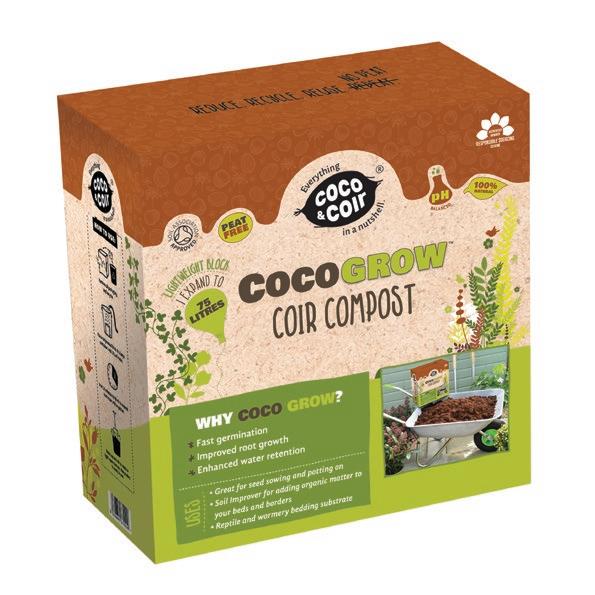

COMPRESSED PREMIUM COCO BLOCKS UNLOCK HYDROPONIC SUCCESS WITH
CO2 for Higher Temperatures in Veg
The significant increase in growth is the most important and obvious benefit of adding CO2 to the grow room. Similarly, supplementing CO2 levels during the first two or three weeks of flowering can kick-start blooming and boost flower size. CO2 supplementation is much more effective when temperatures are above 85°F (27°C). Plants need heat to perform extra photosynthesis.
A CO2-rich environment makes plants more tolerant of heat. Maintaining CO2 levels of 1200-1500 PPM in the growing environment allows some plants to handle higher temperatures of up to 95°F (30°C). Therefore, supplementing with CO2 can make running a grow room at a higher temperature easier. This technique can be beneficial to growers struggling to keep temperatures down.
Adding CO2 can increase plant growth by up to 20% when using HPS lights. Other HIDs like LEC/CMH grow lights also benefit from extra CO2 Large LED fixtures will increase moderate growth. On the other hand, small LEDs or fluorescent grow lamps (CFLs or T5s) will induce minor changes due to the small amount of heat they create. Reduce temperatures in the latter part of flowering to avoid damaging maturing flowers or fruits.
Flowering Stage
Temperatures should be slightly higher in the flowering stage than in veg. The general range is between 70-82°F (21-28°C), and the humidity levels should be 35-45%. Exposing plants to temperatures above 86°F (30°C) in the flowering stage, especially towards the crucial second half when fruits and flowers are in the peak of maturation, can be disastrous for plants. Low-quality fruits and flowers and reduced terpene levels are often the result of high heat exposure. Monitoring temperatures at this stage will help the plants produce the best quality.

Stress Ripening
Cold weather can stress plants and trigger changes in their metabolism. However, if handled carefully during the final stages of flowering, cooler temperatures can boost colours, flavours, and aromas in flowers and fruits.
Gently inflicting stress on the plant during the flowering stage activates the plant’s self-defence mechanism without causing irreparable harm. The plant is tricked into expecting an imminent frost, sending all its reserves into making its flowers or fruits as big as possible to protect itself.
Depending on the plant, you can reap serious rewards by gradually lowering temperatures to around 60-62°F (16-17ºC) during the last week or two of bloom. Some people even shock ripen their plants by flushing them with icecold water for 24-48 hours before harvest to push for that final boost.
Cold weather can also provoke an attractive array of autumnal shades in specific species and genetics. Foliage can transform into shades of deep purple, red, or blue during the cold conditions in the final few weeks. It is always best to seek proper advice on your crop before trying this out, as the last thing you want is to destroy all your hard work at this crucial point.
Tools
Many tools help manipulate environmental conditions in a grow room. Thermometers and hygrometers are essential. Dependent on the size of the room, heaters may help increase temperature, while air conditioners, inline fans, and ventilation equipment will lower and maintain conditions. A humidifier and a dehumidifier are excellent for monitoring humidity rates.
In larger rooms, environmental control systems take much of the guesswork out of growing. Sensors keep track of the overall environment, signalling the slightest fluctuations in temperature and humidity and regulating them within the set parameters.
Use three or four sensors to provide a realistic overview of the whole tent. The canopy is where the magic happens, but a lot more is happening at the base of the plant. It is essential to find any hot or cold spots in the tent, so spread the sensors around at different points and heights in the grow room.
Achieving and maintaining a suitable growing environment is crucial to mastering indoor growing. 3
BIO An industry veteran with over 20 years of experience in a variety of roles, Rich is currently a business development manager for a large UK hydroponics distributor. The author of the Growers Guide book series, Rich also writes on all aspects of indoor gardening. He is also an independent industry consultant, working closely with hydroponic businesses worldwide.
2727 TEMPERATURE CONTROL
if handled carefully during the final stages of flowering, cooler temperatures can boost colours, flavours, and aromas in flowers and fruits
Grow Bigger Yields, Organically






And unlock peak crop performance previously thought impossible with organic inputs.




This game-changing line of organic inputs combines Mother Nature’s fertility with modern-day technology, resulting in clean, and heavy yields that outperform competitor crops in the marketplace.
What’s more, each product in the OG Organics™ suite are produced in Europe following the same formulation and organic quality standards than the products produced in our site in the USA, which are CDFA (California Department of Food and Agriculture) and OMRI (Organic Materials Review Institute) certified.




Advanced Nutrients’ innovations in organic inputs enable you to bring your crops to their TRUE genetic potential.
















The Ocean’s Power To Heal
The holistic practices of regenerative ocean farming can restore the balance in the ocean, on land, and between people.

BY JENNIFER COLE
30
It’s kelp season at GreenWave’s Connecticut ocean farm. Everyone is on the water harvesting, so it takes a few days before anyone answers my request for an interview. In the meantime, I continue researching what seems too good to be true; a farming method that provides jobs and boosts the vitality of the ocean rather than simply taking from it.
A study by researchers at the University of California says regenerative ocean farming of seaweed and bivalves on less than 4% of federal waters off California’s coast can neutralise all of the state’s agricultural greenhouse emissions[1]. But how is that possible?
“Just like regenerative land-based agriculture restores health to terrestrial soil, regenerative ocean farming restores the ocean’s ability to sequester carbon, filter nitrogen, and requires no inputs of feed or fertiliser,” explains Sam Garwin, director of market development at GreenWave.
These accomplishments are a big deal; greenhouse gas emissions have caused ocean temperatures to warm by 1.5°F, water acidity to increase by 30%, and oxygen levels to decrease by 2% [2][3] [4]. The ocean’s ecological balance has altered, diminishing food sources for fish stocks, which, in some cases, have been reduced worldwide by 35%.
Restoring Equilibrium
This imbalance in the ocean spurred Bren Smith to co-found GreenWave in 2014. Inspired by his own experiences, GreenWave’s goal as a non-profit organisation is to provide training and support to ocean farmers worldwide to scale the planting of regenerative ocean crops, leverage economic benefits, and create positive climate impacts.
In the 1990s, Smith was a fisherman in Newfoundland. But when cod stocks depleted due to overfishing and poor environmental management, Smith and thousands of others found themselves without jobs. He turned to oyster farming off the coast of Connecticut, but after his crop was wiped out twice by the powerful storm surges generated by hurricanes Sandy and Irene, Smith had his ‘eureka’ moment.
Unless we discovered a new way to make a livelihood from the sea, there’d be no jobs for anyone, and the ocean would remain a ‘dead zone’.
Land-based regenerative agriculture encourages a bio-diverse array of crops, each working symbiosis to add nutrients to the soil and for each other.
“Regenerative ocean farming is no different,” says Garwin.
If given a chance, shellfish, such as oysters and mussels, can filter up to 50 gallons of water daily and remove harmful atmospheric greenhouse gases absorbed by the ocean, like nitrous oxide. The idea is to combine shellfish with seaweed, such as kelp, which absorbs five times as much carbon as land-based plants. When in sync, seagrasses and other plant life grow and become home to juvenile crabs, fish, and invertebrates, restoring dead zones and acting as natural reefs that mitigate coastal erosion [6][7][8][9]
Smith’s innovative 3D polyculture method of ocean farming is an underwater sea garden anchored to the ocean floor by buoys connected by horizontal ropes six feet below the surface. From these lines, kelp grows vertically next to scallops in hanging nets and mussels held in suspended mesh socks. Oyster cages rest on the sea floor, and clams bury themselves in the mud.
Considered a pioneer in ocean regeneration, Smith was named one of Rolling Stone Magazine’s 25 visionaries in 2017, a prestigious list of people changing (and maybe saving) the world through politics, economics, technology, science, agriculture, or medicine. In 2021, GreenWave won the Food Planet Prize [10] for its innovation and ability to create sustainable planet-wide food systems within ten years. GreenWave aims to train 10,000 ocean farmers through its seed-to-sale online training hub within the next decade.
“We already have 4,500 registered users,” Garwin says. “By creating a worldwide network of farms working collaboratively, we will restore the ocean and the land.”
The statistics speak volumes regarding job creation and the economic benefits of regenerative ocean farming. The commercial seaweed market is projected to exceed $95 billion by 2027, and the World Bank predicts farming just 1% of the ocean could create 50 million jobs [11][12]
Connecting Land and Sea
As farmers worldwide struggle to grow more food but use less chemical fertilisers, seaweed, such as kelp, is an alternative bio-stimulant.
31
31 THE HEALING OCEAN
a farming method that provides jobs and boosts the vitality of the ocean rather than simply taking from it
GreenWave aims to train 10,000 ocean farmers through its seed-to-sale online training hub within the next decade




32
For example, by adding kelp or noir to livestock diets, farmers can cut methane emissions by over 80% in cows and up to 80% in sheep. Seaweed can also reduce greenhouse emissions by acting as an alternative to fossil fuel-based products, including fertilisers and plastic packaging [13]
British Columbia’s Cascadia Seaweed is a firm believer in the Greenwave Method. The company runs a polyculture farm featuring an array of seaweed.
“We are practising sustainable aquaculture to support regenerative agriculture,” explains Erin Bremner-Mitchell, the communications and engagement manager.
At its core, regenerative farming is a holistic approach to growing that restores a relationship with the land, ocean, and the community it supports.
Often, consultation about land and water use hasn’t acknowledged the sovereignty that Indigenous populations have held to it for millennia. Determined not to repeat past mistakes, Cascadia has allied with Indigenous communities along the coast of British Columbia, inviting them into a full partnership. “It’s an opportunity to make up for lost time,” says Bremner-Mitchell.
Learning From The Past
Sceptics of regenerative ocean farming point to how commercial fish farming was once considered a sustainable resource but has fallen short. Removing fish from natural environments, penning them, and pumping the water full of antibiotics and fish by-catch has affected entire ecosystems. A 2021 study by the University of British Columbia acknowledged the highly contagious piscine orthoreovirus prevalent in farmed fish had also infected wild salmon who swam near fish farms [14]
However, the non-disturbance principles of land-based regenerative agriculture also apply to the ocean. No additives enhance crop production, and the ocean’s natural nutrient cycle remains unaltered.
For centuries, people have harvested the ocean. In the 18th century, coastal communities in North America and Europe stripped the sea of wild kelp and turned it into potassium-rich ash for pottery, glass, soap, and textiles. Once deforested – the ocean, like a land-based forest, doesn’t quickly rejuvenate.
Dr Jennifer Clark is the head of science for Cascadia. She works with Simon Fraser University to create a seed bank to preserve the unique genetic diversity of kelp in the Pacific Northwest so that it will always be available when the ocean needs it.
Meanwhile, GreenWave is working with the U.S. Department of Agriculture to identify kelp strains that will benefit a warming planet the most.
“Science has always been our north star,” says Garwin.
They are reconciling the past, restoring the earth, and providing tools so others can carry on the tradition. Could regenerative ocean farming be the answer the world has been looking for?
“When you look at Earth from space – it’s the blue oceans, not the land, that stands out,” Bremner-Mitchell says.
Although Garwin and Bremner-Mitchell caution that nothing alone can fix our broken planet, regenerative ocean farming is making headway. 3
Footnotes:
1. Blue Growth Potential to Mitigate Climate Change through Seaweed Offsetting: Current Biology (cell.com)
2. Ocean Warming - Woods Hole Oceanographic Institution (whoi.edu)
3. Ocean acidification | National Oceanic and Atmospheric Administration (noaa.gov)
4. World Bank Document (rebrand.ly/y3d95eu)
5. Oyster Reef Habitat | NOAA Fisheries
6. Habitat value of bivalve shellfish and seaweed aquaculture for fish and invertebrates: Pathways, synthesis and next steps - Theuerkauf - 2022 - Reviews in AquacultureWiley Online Library
7. Seaweed: A potential climate change solution - ScienceDirect
8. The Effects: Dead Zones and Harmful Algal Blooms | US EPA
9. GreenWave - Taking ocean farming to new depths - Food Planet Prize
10. The decline in global oceanic oxygen content during the past five decades | Nature
11. Commercial Seaweed Market size to exceed $95bn by 2027 (gminsights.com)
12. Regenerative Ocean Farming Factsheet (urbanoceanlab.org)
13. Red seaweed (Asparagopsis taxiformis) supplementation reduces enteric methane by over 80 percent in beef steers | PLOS ONE
14. Suppressed science shows fish farms endanger wild salmon - David Suzuki Foundation
Additional Resources
• Commercial Seaweed Market size to exceed $95bn by 2027 (gminsights.com)
• Evolution of global marine fishing fleets and the response of fished resources | PNAS
• Frontiers | Engineering A Low-Cost Kelp Aquaculture System for Community-Scale Seaweed Farming at Nearshore Exposed Sites via User-FocusKelp: the unsung hero of carbon dioxide absorption (theborneopost.com)
• Kelp forests capture nearly 5 million tonnes of CO2 annually | New Scientist
• Stop Nitrogen Pollution of Oceans – Green Algal Slime Busters | Ocean River Institute
BIO Jennifer Cole is a writer and garden enthusiast with a bachelor’s degree focused on history from Simon Fraser University, and a freelance writing career spanning two and half decades. Jennifer lives in Vancouver British Columbia. Her by-lines have regularly appeared in the opinion section of the Toronto Star and her portfolio includes articles in various newspapers, magazines, and websites across Canada. When not writing her own blog or visiting local garden centres, you can find her puttering, planting, and nourishing her own urban garden oasis.
3333
THE HEALING OCEAN
The commercial seaweed market is projected to exceed $95 billion by 2027, and the World Bank predicts farming just 1% of the ocean could create 50 million jobs
The Potential of
Seaweed Extracts in Hydroponics
Seaweed extract has traditionally been used in organic farming as a natural biostimulant. The go-to seaweed species is Ascophyllum nodosum, found on northern Atlantic shores. Seaweed extracts are not so readily associated with hydroponics. However, many popular “booster” additive products marketed to indoor growers primarily comprise seaweed extract! You may be using it without realising it, especially if you’re a fan of ready-to-use foliar products.
Seaweed extracts are not so readily associated with hydroponics. However, many popular “booster” additive products marketed to indoor growers primarily comprise seaweed extract!

BY EVEREST FERNANDEZ
34
These days, seaweed extracts reveal themselves in planer, lesshyped packaging, while their potential benefits as full lifecycle additives in hydroponic reservoirs are more widely acknowledged. Hydroponic growers considering the use of seaweed extracts in their reservoirs need to be mindful of selecting only ultra-pure forms, completely free of residual solids, to mitigate the risk of clogging irrigation systems and maximising the working life of the nutrient solution.
For the uninitiated, here are some of the most commonly purported benefits:
1. Growth Enhancement: Seaweed extract contains natural plant hormones like auxins, cytokinins, and gibberellins that may play roles in regulating plant growth processes. Some studies show extracts can increase root development, branching, and flower/fruit production to a modest degree, but results vary across plant species and growth stages.
2. Stress Tolerance Aid: Compounds like antioxidants in seaweed extract may help reduce cellular oxidative damage in plants under certain environmental stresses. Growers using high-performance LED grow lights and carbon dioxide supplementation should pay close attention!
3. Potential Foliar Absorption: Applying seaweed extract as a foliar spray could allow some nutrients and compounds to be directly absorbed by leaves. Initial research shows possible benefits for photosynthesis, energy production, and growth when applied at concentrations of 1-10 ml/L. Yes, that’s a wide range, so check the product’s instructions, as application rates can vary dramatically between brands. Manufacturers typically do not publish their bioactive content concentrations.
While seaweed extracts show some promising possibilities, as mentioned earlier, these products have historically been the mainstay of soil growers. Hydroponics enthusiasts are right to be tentative when putting organic additives into their nutrient reservoirs; there is a legitimate risk of fouling the nutrient solution after a few days and having to dump precious fresh water and nutrients prematurely. Your local grow store can help with specific product recommendations.
Further reading:
1. Khan, W., Rayirath, U. P., Subramanian, S., Jithesh, M. N., Rayorath, P., Hodges, D. M., ... & Critchley, A. T. (2009). Seaweed extracts as biostimulants in horticulture. Scientia Horticulturae, 132(1), 26-39.
2. Du Jardin, P. (2015). Plant biostimulants: definition, concept, main categories and regulation. Scientia Horticulturae, 196, 3-14.
3. Craigie, J. S. (2011). Seaweed extract stimuli in plant science and agriculture. Journal of Applied Phycology, 23(3), 371-393.
Vital bioactive compounds found in seaweed extracts include:
• Phytohormones: Natural plant hormones (cytokinins, auxins, and gibberellins) coordinate cellular processes, leading to improved growth characteristics such as increased shoot and root growth, higher flower numbers, enhanced fruit and bud set, elevated chlorophyll content, and an overall boost in yield.
• Betaines: Modified amino acids that play a crucial role in safeguarding plants against environmental stresses like drought, salinity, heat, and cold stress.
• Polysaccharides: Seaweed extracts’ polysaccharides can enhance plant resistance against various stressors, including biotic factors like pests and diseases. As well as alginic acid, other notable polysaccharides found in seaweed extracts include laminarin, fucoidan, and mannitol.
Certainly, more research is required to fully understand the best practices for maximising the potential of seaweed extracts as a sustainable supplement for plant growth and stress tolerance. However, mounting anecdotal evidence from indoor hydroponic growers using high-intensity LEDs shows that seaweed extracts are invaluable for keeping plants thriving, not just surviving, under intense cultivation environments.
Seaweed extracts suitable for hydroponics include Botanicare Seaplex, Ecothrive Flourish, and Growth Technology Nitrozyme. For root feeding, typical dose rates are just 0.5 ml / L or 1 tsp/gallon. 3

SEAWEED EXTRACTS 3535
Canada’s only Community Supported Fishery in British Columbia proves that the little guy can beat the odds and save the ocean.

Community Supported Fisheries
Local Fish To Fork
Local Fish To Fork
BY JENNIFER COLE
36
You’ve heard of a CSA before, but a CSF might be something new, depending on where you live.
“A community-supported fishery (CSF) encourages eating with the ecosystem and the seasons. This creates sustainable livelihoods,” explains Sonia Strobel, cofounder of Skipper Otto, Canada’s only CSF. Founded in Vancouver, British Columbia, in 2008 by Sonia and her husband, Shaun, the venture is named after Shaun’s Dad, Otto, a local angler [1]
Thousands of B.C. families harvested seafood sustainably when Otto started fishing in the 1960s. By the late 20th century, everything was different. Changes in government regulations opened the door for large international corporations. Factory ships prowled the waters, over-catching fish, processing it on board, and shipping it to faraway places. Locals never even got to enjoy it.
“The irony is that this way of fishing was considered a form of marine conservation,” Strobel says.
The belief was that fewer people fishing the ocean would save it. Strobel says 90% of the fish caught in Canada is exported elsewhere, and 80% is imported from other countries.
“It makes no sense,” she says.
Striking Similarities
Land-based conglomerations of farms by large agricorps were meant to improve farming resources. But the monocultural approach to growing stripped the soil of nutrients and forced the small farmer out of business. The same has happened with fisheries.
“The destruction of ecosystems, lower wages paid to harvesters like my father-in-law, and no local produce for consumers was the result,” says Strobel.
While only one CSF exists in Canada, over 200 operate in the United States. Strobel is hoping to change that through mentorship and education. Skipper Otto is working with First Nation communities in Nunavut to determine whether a CSF supporting locally caught arctic char is possible.
How Does A CSF Work?
When you sign up for a CSA, you buy shares in what a farm produces that season. When the farmer harvests the crop, you get a return on the investment through a weekly or bi-weekly
produce box. The contents of the box change depending on what’s in season.
CSFs are the same; members pay upfront at the beginning of the year and receive fish and shellfish as it becomes available. Because the fish is sold before it’s caught, the model guarantees that local fishers know the price of their catch and that there’s a guaranteed market for it [3]
Benefits of a CSF
No one wants to eat salmon every week, so this encourages the harvest of various species, ensuring that the ocean is not overfarmed, preserving its complex ecology. Fishers can alter their target species based on what is abundant rather than what is in high demand by a global supply chain.
Every seafood package Skipper Otto members receive comes with a photo of the person who caught it and details about where it came from. Skipper Otto strives to create a new bridge in the local food system that educates members about the abundance and diversity of the sea.
“Many people don’t know that hake is the most abundant fish in the waters off coastal B.C.,” says Strobel. “It’s being fished daily by factory vessels and shipped to Eastern Europe. But very few people in B.C. have tried or know what it is. We’re now beginning to catch and treat it as a local food source, something that wouldn’t happen without a vibrant local fishery.”

Skipper Otto’s cooperative comprises 45 fishing families, supplying fresh catches to 8,000 CSF subscribers. That number will hopefully continue to grow, proving that the little guy can take on Goliath and win. 3
Sources:
1. Buy Sustainable Canadian Seafood Online - Skipper Otto
2. History of Commercial Fisheries | The Canadian Encyclopedia
3. Community Supported Fisheries (CSFs) | Market Your Catch (ucsb.edu)
37
37
A communitysupported fishery (CSF) encourages eating with the ecosystem and the seasons.
The Benefits of Using

shade cloth on Yield and Quality of Vegetable Harvests

home gardeners need strategies to optimise their harvest

BY ANNE GIBSON 38
I use shade cloth covers to create a shady microclimate during hot weather to stop lettuces from bolting
Hoophouse style crop protection with shadecloth
Many of our favourite vegetable plants are adversely affected by sunburn, heat stress, poor yields and quality due to environmental factors. It’s not only commercial growers that need to protect their crops from these problems; home gardeners need strategies to optimise their harvest. Many places worldwide are facing hotter and drier growing conditions. So, it’s essential to find ways to protect our edible crops to minimise damage, improve growth and harvests.
Like many gardeners, I’ve battled intense UV rays, heat waves, and drying winds in our subtropical climate for years. High temperatures (35–40°C) caused by increased solar radiation can devastate plant growth and reproductive development. While plants need sunlight to photosynthesise, too much light and heat can cause crops like lettuce, rocket and coriander to bolt quickly. Using microclimates with filtered light is an excellent strategy, and shade cloth can help.
Considerable research into using shade cloth in different colours and shade ratings provides insights into a viable solution to some of these challenges. Multiple studies (2) reveal improved yields and quality of many crops, including fruits, vegetables, ornamentals, herbs and tea.
How Does Shade Cloth Work?
Using shade cloth enables us to control the microclimate conditions under which plants grow. We can safeguard crops from potentially damaging environmental conditions, including excess sunlight radiation, drought, high temperatures, frost, drying winds, hail and flying pests.
Shade cloth is made from various materials, including polyethylene, polypropylene and polyester or acrylic by-products. Netting varies in light transmission rates, reflection and absorption of light, and air permeability depending on the shade intensity and colour. The higher the shade factor of the woven fabric, the more radiation is blocked.
Knitted shade cloth is ideal for home gardens because it is hardwearing, long-lasting, UV resistant, lightweight, and easy to handle. It is made from polyethylene that deflects light and heat.
The density percentage refers to the level of sunlight that is blocked. For example, 30% shade cloth stops 30% of the sunlight from penetrating the plants underneath. This density suits many fruiting crops that can tolerate heat. Heat and light-sensitive plants like lettuce and leafy greens grow well under higher density shade of 50% without harming growth.
It’s a balancing act between plants receiving sufficient energy from the sun to photosynthesise and enough shade relief to mitigate potential damage.

Does the Colour of Shade Cloth Matter?
The research confirms yes! White shade cloth reflects heat and light, making the temperature cooler. Darker colours, like black, absorb the sun’s heat while filtering the light.
Neutral shades (black, grey and white) reduce the quantity of light that reaches plants. Whereas coloured photo-selective netting (blue, red, yellow and pearl) diffuses or filters out different light spectrum wavelengths. The pearl net scatters light to a greater extent than any other colour.
Coloured shade cloths filter light in ways that affect plant responses. Light affects plant photosynthesis, leaf growth and size, crop size, yields, and phytochemical production.

39
too much light and heat can cause crops like lettuce, rocket and coriander to bolt quickly
39
SHADE CLOTH
Green shade cloth provides filtered light for many plants needing some sun relief


















visit: GCmag.co/Product-Spotlight See what’s new in the growers MARKETPLACE MARKET PLACE PRODUCT SPOTLIGHTS
For example, one study (5) reveals that red and yellow nets stimulate the vegetative growth cycle and foliage vigour on cilantro-coriander, parsley, and basil. Meanwhile, blue netting was found to stunt growth and decrease yields. The research concludes that various plant species respond differently under different coloured nets.
It is clear from the various studies that no one-size-fits-all shade cloth optimises the results for all plants! Each species has a complex interaction with light. One study (4) explains that “plants respond to light quantity, quality, direction, and periodicity. There are numerous photoreceptors in plants, including chlorophylls, phytochromes, cryptochromes, phototropins, and ones that react to green light. Light and other environmental cues enable plants to adapt to environmental conditions.”



Key Findings on Popular Crops
There’s a wealth of research across a wide range of crops. These are a few results for some of our favourite vegetables.
Capsicums: Research(1) on bell peppers (capsicums) found that yields improved significantly under 35% black shade cloth compared to unshaded plants. The plants were less prone to blight and sunscald. “Optimal shade level for maximal fruit yield was that which maximised the cooling effect resulting from the reduction of infrared (IR) radiation and minimised the decrease in net photosynthesis resulting from a reduction in photosynthetically active radiation (PAR).”
Interestingly, the soil temperature under shade cloth was reduced to the optimum temperature of 27°C. Additional benefits of shading peppers include less moisture loss and an extended harvest season. Capsicums had the best yields and quality under 30-47% shade cloth(1)
Lettuce: Another study(3) confirmed 37% shade under red nets to 55% under black nets provided optimal light conditions for growing lettuce in summer. The leaf size increased, heads were bigger, and outer leaves were greener, softer and more tender than non-shaded lettuce. Nutritional content was significantly higher in non-shaded control plants and under the pearl colour than in other nets.
Tomatoes: Responded best under 35%-50% shade intensity netting with pearl and red colours achieving the best overall results. Red shade cloth had the highest nutritional results(6)
Cucumber: Yields were highest under pearl shade cloth(7)
4141 SHADE CLOTH
Each species has a complex interaction with light.
Filtered light under an awning or pergola might be an option for growing in partial sun
Leafy greens under green shade cloth reducing the potential for bolting and water loss
Trust and Quality, for the most demanding growers

Shade cloth can be used on a small scale in home gardens in many ways. It can be installed over arches, vertical garden structures and as temporary, seasonal covers that can be rolled up and stored in the cooler months. I can’t imagine growing our summer garden without it. We want lots of leafy salad ingredients, but growing them is challenging in the heat.
What are the Key Takeaways?
Using shade cloth provides distinct benefits for mitigating the impact of climate-related weather and growing conditions.
Plant species respond uniquely to different coloured nets. Choose one that will protect the plants we want to grow. Studies(2) show shading can decrease air temperature by 1–5°C, reducing heat stress.
For home gardeners, particularly those that experience hot summers with intense sunlight and heat, shade cloth at 35% shade level can provide some significant benefits for a range of crops(6) and particularly in a light colour. 3
References:
1. Bell Pepper (Capsicum annum L.) Crop as Affected by Shade Level: Fruit Yield, Quality, and Postharvest Attributes, and Incidence of Phytophthora Blight (caused by Phytophthora capsici Leon.) Hortscience 49(7):891–900. 2014.
2. Zhang Q, et al (2022) Color Shade Nets Affect Plant Growth and Seasonal Leaf Quality of Camellia sinensis Grown in Mississippi, the United States. Front. Nutr. 9:786421.
3. SZ. Ilić et al. Light modification by color nets improve quality of lettuce from summer production, Scientia Horticulturae, Volume 226, 2017, Pages 389-397, ISSN 0304-4238.
Advantages of Shade Cloth

Many studies reveal consistent results and benefits over a wide range of crops. Overall, shade cloth nets of any colour with moderate shading (30-50%):
• Prevent fruiting crops from suffering sunburn.
• Decrease moisture loss and water stress.

• Increase water use efficiency in plants.
• Protect crops from excessive solar radiation and insect, bird or hail damage.
• Modify the air, plant and soil temperature, shade and humidity growing conditions.
• Increase the size and colour of leaves.
• Control light quality by increasing diffused (scattered) light.
• Enhance the quality and yield of many crops.
• Reduce watering requirements.
4. Use of Colored Shade Netting in Horticulture. Robert H. Stamps. Hortscience Vol. 44(2) April 2009.
5. Ilic, Zoran & Fallik, Elazar. (2017). Light quality manipulation improves vegetable quality at harvest and postharvest: A review. Environmental and Experimental Botany 139 (2017) 79–90. 139. 79-90.
6. Nangare, D.D. et al. (2015). Effect of green shade nets on yield and quality of tomato (Lycopersicon esculentum Mill) in semi-arid region of Punjab. Asian Journal of Advances in Basic & Applied Sciences. 1. 1-8.
7. Tafoya, Felipe et al. (2018). Sunlight transmitted by colored shade nets on photosynthesis and yield of cucumber. Ciência Rural. 48. 10.1590/0103-8478cr20170829.
BIO Anne Gibson, The Micro Gardener, is an author, speaker and urban garden community educator on the Sunshine Coast, in Queensland, Australia. Anne is passionate about inspiring people to improve health and wellbeing, by growing nutrient-dense food gardens in creative containers and small spaces. Anne regularly presents workshops, speaks at sustainable living events, coaches private clients and teaches community education classes about organic gardening and ways to live sustainably. She has authored several eBooks and gardening guides. Anne shares organic gardening tips and tutorials to save time, money and energy on her popular website - TheMicroGardener.com
43
Shade cloth can be used on a small scale in home gardens in many ways. It can be installed over arches, vertical garden structures and as temporary, seasonal covers that can be rolled up and stored in the cooler months
SHADE CLOTH
If shade cloth isn’t an option an undercover area semi-shaded microclimate might be a possibility


New Technology, Research and Development, and What’s Next for Farming

When I first started in the indoor growing business, I always expected giant leaps and technological advances as the industry expanded and grew. Fast forward a few years, and I’m still astonished at how little advancement has been made in indoor cultivation. I remembered sitting down with companies talking about cameras tracking leaf changes and predictions about AI. However, I still have not seen this come to fruition in the industry. People have started and stopped, but nothing was available that I could sink my teeth into and test at the R&D farm. This was always strange; it felt like the next step in the evolution of indoor growing.
FINALLY!
Just this last week, my mind was blown when I was asked to design an experiment and run the R&D using cameras with AI tracking leaf changes, feeding that information back to my Reliable Controls automation system in my indoor farm. We will run four or five different channels on the LED lights to adjust the spectrum and power to match the exact stage of plant growth. This project is what I have been wanting and expecting for many years! Until now, it seemed reserved for large-scale operations and very expensive.
This new partnership will allow everyone to take the specific spectrum and intensity levels and help map their greens at home to a better characteristic of light levels and intensities. The most crucial element for me is to predict what happens next. Imagine your plant becomes deficient in one aspect, and
the cameras detect it and can tell you to add a specific fertiliser or naturally change the light spectrum to help the plant uptake more.
So Many Pros
This technology has the potential to help conserve water, reduce nutrient usage, stop overwatering and runoff, and do many more beneficial things for the environment. I hope to review and apply it and advise the public on how to grow food indoors. These types of ventures are precisely what the industry needs, and we must support these companies to help us move into the future of better and increased indoor food production.
This experiment will prove exciting; I look forward to discussing the results once complete! Stay tuned. 3
BY ADAM CLARKE
46
I’m still astonished at how little advancement has been made in indoor cultivation
This technology has the potential to help conserve water, reduce nutrient usage, stop overwatering and runoff, and do many more beneficial things for the environment

Gardening for Wildlife
The habitat we create with native plants for birds, bees, and butterflies provides food and shelter


BY JUDY NAUSEEF 48
The habitat we create with native plants for birds, bees, and butterflies provides food and shelter. After weather disasters, these gardens become safe havens. Attracting wildlife to gardens with native habitats now plays a greater role in mitigating the effects of climate change along with soil and water conservation, storing carbon, growing native plants, and reducing fossil fuel use (Garden Culture, Issue 44, 2022).
A tornado recently came through our property. We lost many trees, and others were drastically pruned. The area of our large border was hit hard; the main trees in the shade garden lost most limbs, and the foliage is gone. Luckily, the ground layer of perennials and shrubs remains. Where were the birds and flying insects during the storm, and how many perished?
The birds have since returned to my yard, on our lopped-off white pines, existing small trees, and perennials. Our country road was full of debris and broken trees and, once cleaned up, had no habitat left except for water for nocturnal frogs. Now redwing blackbirds, crows, woodpeckers, and even pheasants sing or squawk in my yard all day.
The bird activity may be the result of having built a native habitat. Creating a safe space for wildlife will impact how I repair and plan future gardens. Wildlife gardens improve soil characteristics that resist erosion by wind and water and create favourable growing conditions for native habitats. Fewer resources, such as water and fuel for equipment, will be needed to maintain the garden, and fertilisers and pesticides are unnecessary.
Steps to Prepare Your Garden for Wildlife

1. Extend the habitat area in your landscape.
2. Allow some messiness. Try to keep loose soil and shredded leaves on the ground. If it is a wild, rough area, leave some stems and even branches. Rotting wood also spurs new
Replace weeds with a plant that enriches the habitat and
Learn to garden in hotter temperatures and drier soils
Learn how to construct temporary shade structures for plants. Use shade cloth and short posts. If the structures are only two to three feet from the ground, it is less likely
Birds Sense Approaching Storms
Wildlife search for shelter during extreme weather. Afterwards, some birds will wander several miles looking for adequate shelter and reliable food sources. Birds recognise changes in air pressure, which are often signals that weather is about to change, according to Kenn and Kimberly Kaufman, the official Birds & Blooms bird experts. When birds sense an approaching storm, they tend to forage more, often coming to feeders for the easiest food source.
They find protection from wind and rain in dense shrubs or small trees planted closely in groups. They will spend the storm in the cavities where they nest fallen trees or holes in live tree trunks. Woodpeckers, bluebirds, and chickadees can hide out in their tree holes. Nest boxes in a landscape will serve the same purpose.
Bodies of birds caught up in the storm are hard to find amid the debris, so the numbers of lost wildlife are unknown. David King, a research wildlife biologist with the USDA Forest Service in Amherst, MA, explains that habitat loss and destruction are more serious than mortality. After a storm, a bird’s instinct is to return to the nesting habitat. They actively forage and may die after extreme weather events if their current habitat can no longer provide food and shelter.
We Can Help Birds Survive Storms
1. Fill feeders with quality seed. Strong and healthy birds will be more resilient to the negative impacts of extreme weather.
2. Create shelters (build boxes) and leave dead-standing and fallen trees, depressions in the ground, and garden or forest floor debris.
3. Create native habitats with food and shelter. Plant a ground layer of perennial grasses and horizontal shrubs; a mid-layer of larger perennials, small and mid-sized shrubs, and small trees; and a top layer of medium to large trees. Include plants that small insect pollinators eat.
49
GARDENING FOR WILDLIFE
The birds have since returned to my yard, on our lopped-off white pines, existing small trees, and perennials
49
Heat waves, wildfires, droughts, and storms threaten many wild species

Resources about wildlife habitat and birds during severe weather:
• Audubon - Gimme Shelter: How do birds survive a snowstorm? rebrand.ly/f30567
• ICPRB - Build a Nesting Box rebrand.ly/z3npkqj
• Perky-Pet - How Birds Survive Devastating Storms - and How You Can Help Them rebrand.ly/g5f1sc2
Give Butterflies Places to Go When It Rains
Butterflies look for shelter from rain when the skies darken as a thunderstorm approaches. They cling to the undersides of leaves, climb deep into tall grasses, or slip into cracks of rocks or trees. They protect themselves from strong winds and roost in the shelters at night. Caterpillars do the same thing, remaining close to their host plants. It is essential to offer butterflies water in bird water sources, depressions that catch and hold water in stones, or fountains.
Extreme weather has an impact on butterfly populations. A large hurricane may destroy habitat, especially on islands and coastal areas where saltwater flooding may kill host and nectar plants. Heat waves, wildfires, droughts, and storms also threaten many wild species.
According to the Environmental Defense Fund, “Restoring habitat and decreasing pesticides are not enough to save butterflies. We have to stabilise climate, too.”
A combination of logging, falling trees, drought in the areas where the butterflies roost, and a reduction of milkweed in their breeding places threaten the monarch’s migration. But the damage wrought by climate change is the biggest factor.
What Can We Do?
To minimise the impacts of climate change, it is important to maintain corridors of suitable monarch and milkweed habitats and
ensure that other pressures on their populations are reduced. The non-profit Monarch Joint Venture suggests planting habitats, educating others, contributing to conservation efforts, and joining citizen scientists to monitor monarchs.
Creating habitats for monarchs also keeps more carbon out of the atmosphere and mitigates global climate change. Plants sequester carbon. When a root, stem or leaf dies, microorganisms in the soil convert the plant carbon into soil carbon. Native plants like milkweed, other flowers, and grasses, which provide habitat for monarchs and other wildlife, have deep roots. Living plants convert and store atmospheric carbon in their roots, stems, leaves, and wood.
When we plant native prairie plants in our gardens, we take a step to affect climate change in a small but real way. Consider, Purple Coneflower, Echinacea purpurea, Butterflyweed, Asclepias tuberosa, Lanceleaf Coreopsis, Coreopsis lanceolata, Prairie Dropseed, Sporobolus heterolepis, and Black-eyed Susan, Rudbeckia hirta
Resources about wildlife habitats and butterflies during severe weather:
• NPR.org - What Happened To The Butterflies? Climate, Deforestation Threaten Monarch Migration rebrand.ly/nioexc1
• Monarch Joint Venture - Climate Change rebrand.ly/f29tc7o
• WWF - Monarch Butterflies and Climate Change rebrand.ly/61d4ab
• Successful Farming - The Power of Prairie rebrand.ly/6cf14f
• The Conversation - Looking back on America’s summer of heat, floods and climate change: Welcome to the new abnormal (rebrand.ly/z3wtghm)

• EDF.org - How Climate Change Affects Monarch Butterflies and What We Can Do About It rb.gy/yu2hd

51
GARDENING FOR WILDLIFE 51
Monarch butterfly on purple coneflower

Create Safe Bee Spaces
Bees are losing their habitat because of climate change, in addition to pesticide use, disease, and habitat loss. Changing temperature and weather conditions have reduced the areas where bees can survive, and pollinators have struggled to adapt, according to new research published in the journal Science.
There are many ways to support bees and pollinators. Planting pollinator gardens with regional plants that bloom throughout the year can provide much-needed forage. Ground-nesting native bees need exposed and undisturbed soil patches free of mulch or other ground covers. Gardeners can clear some ground in a sunny, well-drained area to create dedicated spaces for bees to dig nests. Research has shown how the havens that urban gardeners create provide nectar. According to the Xerces Society, providing nesting sites and reducing or eliminating pesticide use is key to supporting these important pollinators.
A study in the Journal of Insect Science (first author Erin E. Wilson Rankin) links water reduction, plant floral resources and bee health via the impact of water on nectar and pollen. It shows that the nutritional quality and availability of floral resources for honeybees and bumblebees are significantly decreased by reduced water availability to the plants they feed on.
Climate change impacts on bumblebees converge across continents, as reported in Time. “The researchers suggested a number of steps that could temporarily help mitigate the threat to the bees, like assisted migration—a practice where authorities pick up bees and move them—and the creation of ‘safe havens.’ But researchers said that humans must handle climate change comprehensively to save the bees once and for all.”
Global warming contributes greatly to the decline of bees around the world. Some wild bees and other pollinators have only a small temperature window where they can live. When temperatures rise, they move to colder climates to seek refuge, reducing the overall territory they can inhabit and reducing population sizes. This affects the surrounding ecosystem.
Home gardeners can contribute to a vibrant ecosystem by growing pollinator gardens in their yards or community gardens. Providing safe and healthy gardens can reduce stress, improve nutrition, and supply robust habitats for pollinators.
Actions to help bumble bees survive:
1. Conserve and create high-quality bumble bee habitat.
2. Plant native flowering plants, especially frost and droughtresistant ones. Select a diverse group of plants that provide early and late blooming nectar and pollen sources.
3. Submit your observations of bees and nests to BumbleBeeWatch.org or use the phone app.
Resources about wildlife habitat and bees during severe weather:
• Pollinator.org - Climate Change and Bumblebees rebrand.ly/74bcfa
• The Conversation - Urban gardens are crucial food sources for pollinators - here’s what to plant for every season rebrand.ly/246e88

• Xerces Society - Remember The Ground Nesting Bees When You Make Your Patch Of Land Pollinator-Friendly rebrand.ly/f438ea
• Journal of Insect Science - Reduced Water Negatively Impacts Social Bee Survival and Productivity Via Shifts in Floral Nutrition rebrand.ly/30c123
• TIME - Bees Are Losing Their Habitat Because of Climate Change rebrand.ly/3c0109
The many plantings in our landscape provide a home for birds, butterflies, bees, and other wildlife. When serious weather threatens, safe places are close by. 3
BIO Judy Nauseef is a freelance writer, landscape designer, and speaker specialising in sustainability and gardening with climate change. She writes about native plants, habitat gardens, prairie designs, stormwater management, and travel. She is the author of the book Gardening with Native Plants in the Upper Midwest: Bringing the Tallgrass Prairie Home. Her blog and newsletters can be found at judynauseef.com
GARDENING FOR WILDLIFE 5353
When we plant native prairie plants in our gardens, we take a step to affect climate change in a small but real way
Good Vibes
What’s Farming Without Friends?
When I purchased the property Galiano Grow House sits on, I had no intent or desire to start a farm. The idea of some land for the dog was great because it would save me time taking him for walks! I only realised later that farming was missing in my life, not just for growing plants, but for the social experience, meeting new friends, and learning new skills that will leave the world a better place.
I only realised later that farming was missing in my life, not just for growing plants, but for the social experience, meeting new friends, and learning new skills that will leave the world a better place

54 BY ADAM CLARKE
The Social Experiment
What has now become known on the farm as “Adam’s Social Experiment” started with my belief that growing large-scale outdoor crops with toxic chemicals and mass-produced fertiliser would affect humans and the earth more than anything else. We all heard about the $15 head of lettuce. But isn’t the real issue why we even grow lettuce compared to other tastier and more nutrient-dense crops? It seems to me, like so many things in this world, that we are stuck in the past, and things need to change. Lately, many people have shifted from alcohol consumption to low or zero-alcohol beers and cocktails. Why aren’t we seeing the great farming change yet?
Back To Our Roots
My firm belief is that as long as we have large companies producing and pushing the use of products like Glyphosate, we will never advance as a farming society. Why aren’t we looking back to how people did things in the past? My grandfather was born in 1902 as a farmer, and they managed just fine without pesticides. What’s different now? It seems the biggest difference happened in the 70s, with mass farming getting bigger and crop dusting and sprays getting stronger and killing off the natural microbes in the soil. Where do we go next, and how do we get there? As a young guy, I just needed a little help from my friends, and just like that, the farm was created.
Friendly Farmers
Since getting farm status two years ago, we have been expanding, testing and doing more R&D. Of course, as this is building a farm, it is a perfect way to lose money, so a lot of time and goodwill has been needed to progress. We have seven people on the farm from all over the world working towards a common goal of producing food 365 days a year on Galiano and lowering our environmental footprint. Tools like helpx. com have been invaluable to me in getting people to come and help the farm. Currently, we have people from Luxemburg, Quebec, Vancouver, Germany, and England. I am very fortunate to have the support of so many young people, but it didn’t happen without reason. It happened with the common interest of growing food and changing how the world functions. Without these strangers-turned-friends, the farm would never have been able to get to where it is right now. We are continually expanding and learning from each other.
While farming has been an incredible experience for me to see food grow and help the community, I think the best thing about it has been my “social experiment”, allowing me to meet many new friends and learn new things. With each new guest, the farm becomes more culturally diverse and a richer environment for everyone there. I highly encourage everyone to farm with some help from their friends. Feel free to reach out if you are interested in helping on the farm! 3
Bio

Adam has provided planning and design services for cannabis and hemp cultivation and processing facilities over the last seven years with Stratus. His projects involve outdoor cultivation, indoor cultivation, drying, processing, extraction, storage, bottling and packaging, and more. Living on a hobby farm, Adam loves all plants, including flowers, vegetables, and microgreens, but is most passionate about hemp and is in awe of the fast-growing plant and all of the benefits it offers to humans and the environment alike.

5555 SOCIAL FARMING
I highly encourage everyone to farm with some help from their friends



A Grower’s Guide To Using Humic Acids


BY WILLIAM TEXIER 58
Organic matter in the soil is made up of different elements. Humus is the final part of decomposition and is no longer subject to further transformation. All the elements that produced it (dead plants, animals, microorganisms) are completely decomposed, but this represents only a tiny part of the original organic matter. The insoluble part of this humus is called “humin”, and the soluble component “humic acids”.
‘Humic acids’ (note the plural) is the generic name for all soluble organic acids in soil. They are, therefore, not a single molecule but a large family of compounds with common properties. Their extraction process characterises them. There are millions of molecules called humic acids, composed of carbon, hydrogen and nitrogen, with small amounts of sulphur and phosphorus. They are built around carbon chains onto which various groups with negative charge sites are grafted. They can also have hydrophilic and hydrophobic endings. It’s this variety of active sites that makes them so valuable. It’s easy to see why all humic sources are not created equal; among these thousands of molecules, some are much more active than others. Many researchers consider them a collection of agglomerated molecules rather than a single entity. It’s a way of viewing the matter accurately, reflecting how humic acid molecules work. Each molecule part interacts differently with the environment, the soil and plant roots.
Extraction
Any decomposed organic material can be used for extraction. For example, coal, being of vegetable origin, contains humic acids, particularly lignite, low-grade coal. The most common source used for most products on the market is Leonardite, which has the highest level of humic acid compared to all other sources, such as peat, compost or soil.
Leonardite can be thought of as coal that has not been completely transformed. The organic matter began its decomposition under conditions quite similar to peat. Geological movements buried it but did not undergo the pressure and heat necessary to complete its transformation. Leonardite resembles coal, a soft, black or brown rock associated with lignite.
Deposits are generally found at shallow depths in relatively thin layers. Many countries have Leonardite mines, including Spain,
Germany, Hungary, Ukraine, and Scandinavia. There are also significant Leonardite deposits in North America.
The manufacturers do not provide details of the extraction process, but the underlying principle is always the same. Since humic acid is soluble in a base, extraction uses a strong base, usually potassium hydroxide, KOH, which leaves a significant amount of potassium in the solution. To obtain humic acid (note the singular) in its solid form, you must acidify the solution. The acid will settle, forming a potassium humate salt. This extraction process is more complex than I’ve described, involving several stages, such as filtration, purification, and more.
Humic acids have recently been extracted from poplar softwood and sawmill waste. There are few operations of this type, as patents have not been filed for this extraction. The end product can’t be called “humic acids”, even if it has all the same properties. I like the term lignohumate. The extraction process is different, involving heat, pressure, and mechanical treatment. Patents protect the details of the process.
Whatever the source or technique, three fractions emerge from the extraction process: humic, ulmic and fulvic acid , each with very different molecular weights. The largest molecules in the humic fraction are ten times larger than those in the fulvic fraction. Humates, ulmates and fulvates refer to the salts of these acids.
Humic acid
In the singular, humic acid refers to the heaviest fraction of humic acids.
Misleading terms: humic acids (plural) designate all three components, while humic acid (singular) represents the heaviest fraction. This name identity is a source of confusion for many people.
59 HUMIC ACIDS
While providing a food supply for plants, they also chelate toxic metals from the soil, ensuring that crops don’t absorb them
The most common source used for most products on the market is Leonardite, which has the highest level of humic acid compared to all other sources, such as peat, compost or soil

Humic acid (singular) consists of long chains of molecules with a high molecular weight (10,000 to 20,000 g/mol), dark brown to black. In liquid form, it is always in a basic solution, often with a high pH. It’s the heavyweight of the family, which gives it other properties than the much lighter fulvic. I prefer to use it in soil or bioponics (using organic fertiliser in hydroponics). In addition to a good fertiliser, adding humic acid is the best way to improve the soil.
Ulmic acid (or hymatomel)
Ulmic acid carries a medium weight. Strangely, it has no activity on plants and is not used alone.
Fulvic acid

Fulvic acid has molecular weights between 2,000 and 8,000 g/ mol. These are much smaller chains of molecules. In liquid form, it ranges from bright yellow to very light brown. In powder form, it tends more towards orange-yellow or even light brown.
Its small size enables it to be absorbed easily, either by the root or through the stomata. This is the fraction I use in hydroponics, with bare roots or coco substrate. I also use it as a foliar spray.
Humic acid works better on the soil, even if there are direct interactions with the roots, while fulvic acid works better on the plant but also interacts with the soil.
Action of Humic Acids
Physical Action:
Humus-rich soil is light, supple, aerated and moist; it’s an inexhaustible source of molecules useful to plants and a perfect environment for the roots of many species. Humic acids modify and improve soil, which is more long-lasting than fulvic acid. They increase water retention capacity and aeration. For example, they can break clay soil by creating channels through which water can penetrate. They “hold” the soil and reduce the risk of erosion.
Chemical Action:
Humic acids enable inorganic mineral salts to remain in the root zone rather than being washed out by the first watering. They retain elements and transform others, making them assimilable by plants, thus participating in the decomposition of organic matter.
As a result, they also modify the soil. Humic acids improve the absorption of nutrient ions by increasing the permeability of cell membranes. They affect soil temperature and slow evaporation, another way to keep the soil moist.
Humic acids have a high cation exchange capacity and are chelating agents that improve the soil’s buffering effect. A chelate, a word meaning clamps, is a long organic molecule that acts like clamps, sequestering metal ions. They retain or release these ions to help stabilise pH, called the buffering effect.
While providing a food supply for plants, they also chelate toxic metals from the soil, ensuring that crops don’t absorb them.

Biological Action:
Humic acids interact in many ways with plants, starting at the beginning of the cycle as they stimulate germination. I always soak my seeds in a solution of fulvic acid for 12 hours, significantly increasing the germination rate. But for me, the major action is stimulating growth in the root zone, which is essential at the start of the plant’s life. Not only do they increase root mass, but they also improve root quality by promoting the multiplication of the little absorbent hairs. At the same time, they speed up cell division, which accelerates growth.
Later in the cycle, humic acids increase the plant’s vitamin content and generally improve its response to abiotic stress. At the same time, they stimulate microbial activity and promote the proliferation of beneficial microorganisms.
I treasure these molecules and consider them a grower’s greatest allies in soil and hydroponics. For a long time, I thought I only had to use an excellent fertiliser in my nutrient solution to see spectacular results. It wasn’t until I started using Humates that I changed my mind. I now grow with nature’s many allies, but humic acids remain at the top of my list for their wide range of actions and modest price. 3
BIO: William Texier is the Co-founder of Terra Aquatica (formerly GHE) and author of L’Hydroponie pour tous, Mama Editions. He has been working in R&D in hydroponics and plant nutrition since 1987. For more information, visit terraaquatica.com
6161
HUMIC ACIDS
For a long time, I thought I only had to use an excellent fertiliser in my nutrient solution to see spectacular results. It wasn’t until I started using Humates that I changed my mind
up-to-date with our Garden Culture Blog




Our blog is where we bring you more than we can cover in our print issues; timely news, growing tips, and great ideas. Hundreds of growing articles are waiting for you.

Stay
@gardenculturemagazine Stay
GCMAG.co
up-to-date with our Garden Culture Blog
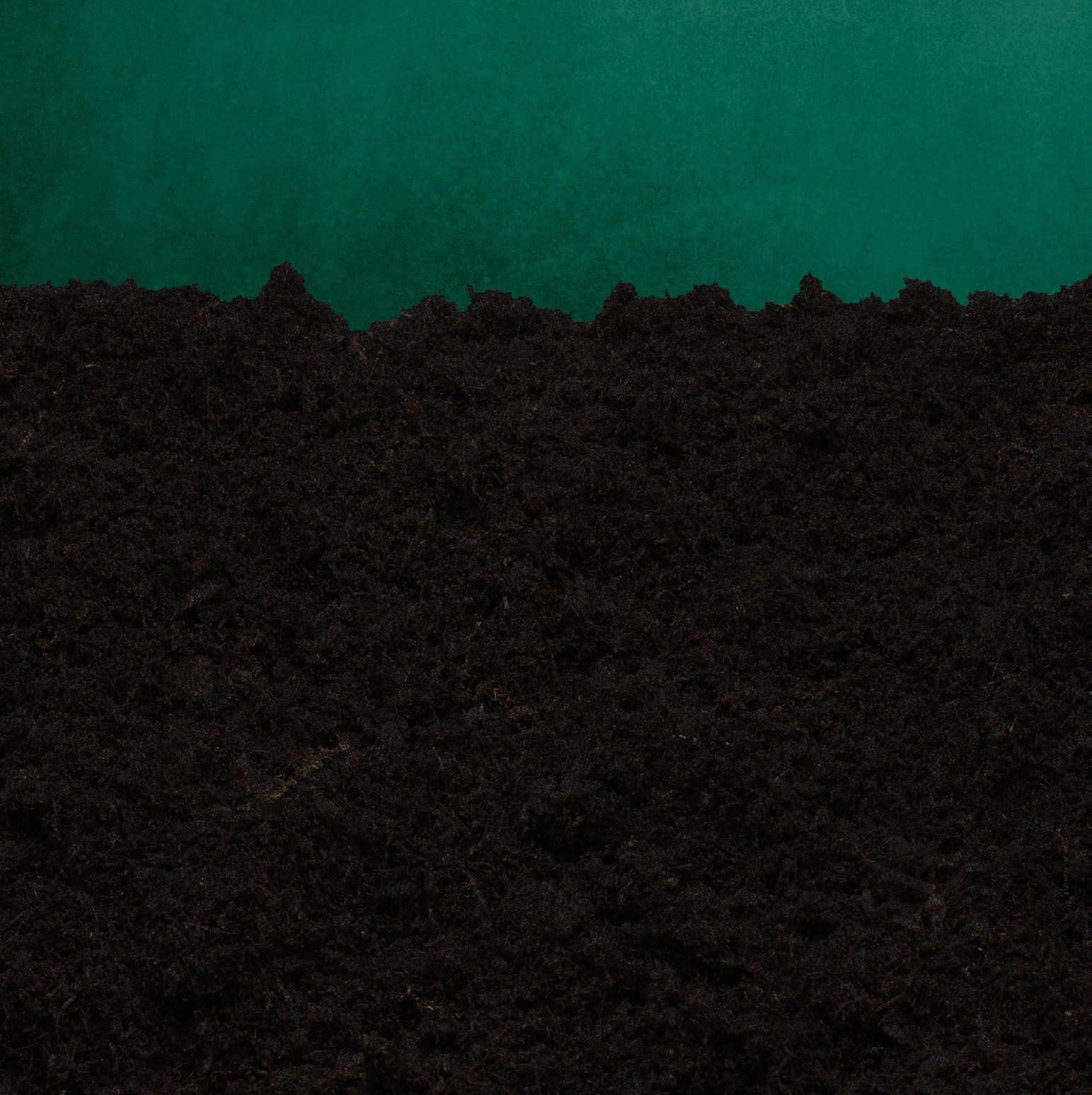





 BY ADAM CLARKE
BY ADAM CLARKE
Psychometrics, Vapour Pressure
and the Seemingly Never-Ending Chase for your Setpoint
One of the most significant aspects of growing indoors is controlling your environment.This doesn’t surprise anyone who knows me because I’m a big supporter of spending money on quality equipment and less on labour. When you have the appropriate equipment, you can control vapour pressure properly in a growing space.
Psychometrics
Coming from a job where all I did was design speciality dehumidification equipment for ice rinks, pharmaceuticals, pools and much more, it was a no-brainer to start digging into how to control vapour pressure in a grow room. The simple explanation is psychometrics, which is the science of measuring the water content of air or how water moves in the air. No water will move and transfer without a proper vapour differential to the space.
I have often heard the term vapour pressure deficit, but coming from the dehumidification world, I always heard it as vapour pressure differential. I thought of it as “what I have minus what I want”, where ‘have’ is the amount of moisture released from the plant minus what I ‘want’ the room conditions to be. This concept is easily defined by psychometrics and the psychrometric chart. However, what isn’t easily defined is what conditions are ideal for growth and not chasing one’s tail.

Define Ideal Conditions
Growers must define the room conditions for ideal growth and match the watering rates, dry back, humidification, and dehumidification. I often see people chasing the “mythical perfect VPD”. But what is that, and how is it accomplished? In my mind, people have dug themselves into this VPD hole to make up for their plant environment being wrong or deteriorating plant health. The perfect VPD is created in the ideal setting for plant growth. We control our rooms to the correct conditions and then ensure we can compensate for the VPD loss or addition.
Growing Pains
For instance, in early veg/flower, the plants are so small that they cannot release enough moisture to account for the water loss in the room’s AC coil. Naturally, you would think that the vapour pressure was wrong. However, the reality is that your intended temp/rh was right but cannot be maintained, and the plants cannot physically transpire enough moisture. In this case, humidification is needed.
This contrasts with late flower, where we have too much water and need to keep blasting the dehumidification/AC in the last week. People tend to need a full equipment load in the last week because it is harder to remove moisture as the air gets colder. This generally means the installed equipment isn’t big enough for the load. When this happens, people try to change to get the same VPD but at different temperatures and humidity. I cannot stress enough that this will drastically affect your crop, so don’t mindlessly chase VPD.
Strive For Plant Happiness
If your VPD is off, something else is likely wrong. Your AC and dehumidifier will change your VPD as much or more than your plants. These pieces of equipment, if misused, will cause plants either not to transpire or over-transpire. Don’t assume room temperature and humidity must change if your VPD isn’t right. First, consider if your plants are healthy and happy. Then you can start adjusting room conditions to achieve the desired VPD. 3
PSYCHOMETRICS & VAPOUR PRESSURE
64
One of the most significant aspects of growing indoors is controlling your environment
WHAT IS MYCORRHIZA?


Symbiosis between fungi (myco-) and plant roots (-rhiza)

Assists 90% of plant species

Exists for 400 million years, known for 150 years, extensive research over 50 years
Effectively extends (10-100X) plant root system



Obligate mycotroph plants, require mycorrhizae to grow optimally
Rarely found in commercial growing media
DYNOMYCO® is a groundbreaking mycorrhizal inoculant developed specifically for growers. It is based on 30 years of scientific research at Israel’s Volcani Center (ARO) and on numerous trials with medical growers in Israel and in the US. DYNOMYCO ® was designed and formulated by a team of biologists, agronomists and soil health experts to help medical cultivators reach their plants’ full potential in terms of yield .





THE DYNOMYCO® DIFFERENCE

BEST OF BREED
World's leader in Mycorrhizal production


Over 30 years of R&D
HIGH CONCENTRATION = FASTER INOCULATION AND POTENCY
900 endomycorrhizal propagules/g

Whole inoculum: spores, hyphae and host root fragments

®
WWW.DYNOMYCO.COM
Quebec’s Reford Gardens Are Good For


The Soul

BY CATHERINE SHERRIFFS 66
Forillon National Park, Gaspé, QC.
Quebec’s Gaspesie region is renowned worldwide for its dramatic coastal landscapes, stunning national parks, and salty seaside air. It’s a place rich in history, beginning with the First Nations people who witnessed the arrival of the Vikings, Italian explorers, and the Basque and Breton fishermen crossing the St-Lawrence (1). You don’t have to book an expensive cruise to see whales or seals in the Gaspé; they’re as much a part of the landscape as the cliffs. With breathtaking hiking trails for all fitness levels and natural wonders like the Percé Rock, it’s the perfect destination for nature lovers looking for peace, quiet, and outdoor therapy.
Road Trip!
With that in mind and a desire to explore our province, my family and I headed to the Gaspesie in early July. Nearly an 11-hour drive from our home in the Laurentians, we broke the journey in half to keep our three kids from going stir-crazy in the back seat. Sleeping under the stars seemed natural for the first night of our eco-tour, so we booked a bubble tent with a transparent roof (that’s right, parents, your dreams of putting your accident-prone middle child in a bubble can come true in Sainte-Flavie, QC!). The next day, we stopped at the Centre d’Art Marcel Gagnon, a unique seaside art gallery featuring wooden sculptures you can only see at low tide, before heading to the Reford Gardens, a place I didn’t know was on my bucket list until I saw it.
Quebec’s Gaspesie region is renowned worldwide for its dramatic coastal landscapes, stunning national parks, and salty seaside air.


Elsie Reford (1872-1967) was the mastermind behind this gorgeous space, although she never set out to be a horticulturist. Instead, she was an outdoor enthusiast and used her camp in Grand-Métis for hunting, fishing, canoeing, and horseback riding. But in 1926, at 54, she was sidelined by appendicitis and needed surgery. Afterwards, her doctor recommended she find less physically demanding activities to occupy her time, so she decided to convert her 20-acre property into gardens.

Elsie Reford and Les Jardins de Métis
Also known as Les Jardins de Métis , the Reford Gardens are located in the northern part of the Gaspé Peninsula, about 300 kilometres northeast of Quebec City. They are the northernmost gardens in eastern North America (2), making the abundance of plant life growing there all the more impressive.

67
67 GARDEN TRAVELS
Lupins in bloom at the Reford Gardens
“Le Grand Rassemblement” at the Centre d’Art Marcel Gagnon in Ste-Flavie, QC

Work In Progress
When she first developed the concept, Reford’s camp was barren except for a spruce-lined entrance and a simple cedar hedge. She dug, built stone walls, and moved trees to create a beautiful forested oasis. Despite the challenging weather conditions, Reford selected rare plant varieties for her gardens, including azaleas and blue poppies from Tibet. She created and fostered relationships with local farmers and fishing guides, trading leaves with the farmers in exchange for refined compost to help her exotic and native plant collection grow. Even with the community’s help, transforming the property took three decades of hard work. I’m unsure how this venture complied with the doctor’s orders for less strenuous activity, but the results were well worth the effort.




Good for the Soul
The word magnificent doesn’t do the Reford Gardens justice, and it’s no wonder they’ve been declared a National Historic Site of Canada. The property features 15 garden spaces and 3,000 plant species and varieties. The Entrance Garden welcomes visitors with winding pathways shaded by mature white spruce trees. Groundcovers and plants of various heights and sizes intermingle along the trail, including Lady’s mantle, sedum, lilies, and cicerbeta. The Entrance Garden also features wooden bridges that cross
the rushing stream that meanders throughout the property. You can’t help but instantly feel at peace, the gardens doing exactly what they’re meant to do for the soul.
Eventually, the gravel paths giveaway to the spectacular Stream Garden, which looks like a well-kept secret nobody else knows about. The hills on either side of the stream are a wild and lush paradise featuring rock gardens, trees and shrubs, stone pathways, and benches for sitting and taking it all in. Irises, mosses, lichens, and unique bonsai shrubs grow in this space, creating a visually exciting and complex ecosystem.
Exotic Blue Poppies
The Reford Gardens are most famous for the blue poppies, which bloom from the end of June through July and are featured in abundance in the Blue Poppy Glade. The blue flowers with delicate petals are tough to grow, yet Elsie Reford succeeded. Native to the alpine valleys of the Himalayas, Reford got the seeds from the Royal Botanic Garden in Edinburgh and brought
6969
Irises, mosses, lichens, and unique bonsai shrubs grow in this space, creating a visually exciting and complex ecosystem
GARDEN TRAVELS
Gaspe landscape
The unique and beautiful blue poppies in bloom at the Reford Gardens.


















































FOR SERIOUS GROWERS www.hygen.com.au SOCIAL MEDIA LOGOS P ACK SOCIAL MEDIA LOGOS P ACK
them back to Grand-Métis around 1935(3). She found the blue poppies loved the moist and mild climate in the region and were protected by the early and heavy snow cover. She shaded them from the harsh sun by growing them under a crab apple and birch tree canopy. The periwinkle blue flowers pop against a backdrop of ostrich ferns, white martagon and Turk’s Cap lilies that round out the space. Anyone open to the horticultural challenge of growing blue poppies in their home gardens can purchase seeds at the gift shop (among many other seed varieties).
Endless Beauty and Inspiration

The Vegetable Garden is what dreams are made of and features crops like Egyptian garlic, kale and cabbages, lettuce greens, and so much more. Surrounded by a white picket fence and pollinator-friendly flowers, it leaves you feeling inspired and hungry for more. The Long Walk is a breathtaking stroll through an English cottage-style garden featuring trees, shrubs, and blooms of all colours. There’s a serene meadow with lupins galore, and the House Gardens make you want to pack your bags and move in for good, if not for the plants, then the gorgeous wrap-around
Sources:
1. Tourisme Gaspesie (tourisme-gaspesie.com)
2. Reford Gardens (jardinsdemetis.com)


porch overlooking them. The Primula Glade and Alpin Garden are a must-see on your way to the Bird Garden, a paradise for bird watchers and gardeners who appreciate everything this species offers. Gorgeous arbours and gazebos covered with honeysuckle are natural nesting spots, as are the many birdhouses scattered throughout the walkways and meadows. The pond in this part of the garden includes a migration ramp for the American eel, which helps the at-risk species access its natural habitat.
La La Land
Our two-year-old fell asleep in his stroller mid-way through our tour, a small miracle if you understand how much energy this kid has. But my entire family could have drifted off after our visit; we felt calm, relaxed, and uplifted. As we headed to the car for the final leg of our journey to Forillon National Park in the Gaspé, I felt justified in some of the plant choices I have made in my garden. If Elsie Reford liked them, they must be wonderful. I also felt inspired to do more and do better. While my garden will never span 20 acres, I can create a space on a much smaller scale that attracts wildlife, improves the soil, and feeds us and our pollinator friends while offering some much-needed garden therapy. I took notes of various plant species I haven’t tried growing and want to incorporate into my property; it’s all part of my 30-year plan. 3
3. Must-See Attractions Gaspesie (attraitsgaspesie.com/en/blog/growing-blue-poppies/18)
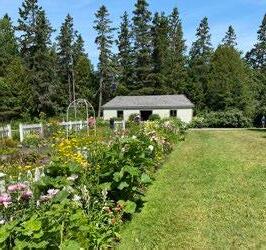
BIO Catherine is a Canadian award-winning journalist who worked as a reporter and news anchor in Montreal’s radio and television scene for 10 years. A graduate of Concordia University, she left the hustle and bustle of the business after starting a family. Now, she’s the editor and a writer for Garden Culture Magazine while also enjoying being a mom to her three young kids. Her interests include great food, gardening, fitness, animals, and anything outdoors.

71
I felt justified in some of the plant choices I have made in my garden; if Elsie Reford liked them, they must be wonderful
GARDEN TRAVELS
Bird garden
StaggeringMushroom Harvests Control as Guide, Rather than Goal


If you’re a practised controlled environment grower, you may be very accustomed to using technology, tools and techniques to try and reproduce the exact conditions favoured by your species under cultivation. Of course, the ideal would be to give them everything they need and nothing they don’t want. But for most growers, maintaining a reasonable environmental range based on the available resource input sets the parameters for which conditions and how much one can control best.
Reduce Energy Expense
To reduce energy expense, where possible, use passive systems of temperature mitigation like insulation, natural shade from deciduous leaves in the summer heat, and ventilation with chimney turbines. Once the most reasonably achieved conditions are determined, no longer aim to control the environment further; instead, control the species selection.
Species Selection
Using your recorded conditions, look for species from regions of the world that have natural seasonal patterns similar to your growing environment. Combining the high heat in summer with the necessary humidity for mushroom formation mimics tropical homes for varieties like the Pink Oyster (Pleuroteus djamor). As the heat can be stressful on spring and autumn-favouring mushrooms, many northern growers supplement their harvest with these in the peak heat season. Cold snaps are more damaging to these types, which narrows their production window and restricts the likelihood of their naturalisation in the home environment.
Thorough Research
To determine which additional species are good candidates, where data is available, seek opportunities to try growing subtypes with natural places of origin that resemble the conditions of your geographical location. As fungi can reproduce and genetically change rapidly, consider the possible consequences of introducing new types to your local wild environment. Harvest mushrooms under cultivation before heavy spore release, and filter air from the fruiting space before it reaches the wild.
To reduce energy expense, where possible, use passive systems of temperature mitigation like insulation, natural shade from deciduous leaves in the summer heat, and ventilation with chimney turbines
If growing similar species, like a selection of different Pleuroteus subtypes from other regions of the world, it makes sense that the occasions of their maximum production would occur at different times when they are in (controlled for) a specific place.
This relative seasonal variation is a function of the conditions unique to the geographical location where each type evolved to prosper. Their life cycle events happen at different temperatures because the local conditions of their evolution are also different.
Still, if spent substrates are distributed outdoors, the chance of wild fruiting remains present, especially if seasonal parameters are very similar. Each land steward will have their unique approach to deciding whether this is a desirable or undesirable possibility. Some may argue that climate change is a good enough reason to allow species resilient in ‘neighbouring’ climate zones (hotter than one’s own at the current time) to interact with local types in hopes of developing variation tolerance. Additionally, some species are at risk of becoming extinct in their home environments, and their replication and propagation in more places could be considered a means of helping to preserve global diversity.
Localised varietals, particularly if found in the wild thriving on the same or similar substrate you use in your grow, are a good choice in many cases. The collected culture may, however, not have an especially vigorous growth pattern and could underperform next to commercialised varieties selected by microscopy practitioners.
72
BY XAVI KIEF
Chestnut mushrooms (Pholiota adiposa)
Only by subjecting multiple types to a parallel, well-controlled test will you know if any are outpaced by the other targeted crops or competitor species within the substrate (leading to contamination and yield reduction).
Aside from being resource-advantageous, try ing different types of oyster mushrooms can also lead to discoveries about which ones are marketable or otherwise attractive, offering a look, taste, or texture unlike others in your collection. For example, Yellow Oysters ( citrinopileatus) and Popcorn (or Branched) Oysters (P. cornucopiae) pin in clusters, grow ing many more and smaller caps than Blue Oys ters and Phoenix types (P. columbinus and narius, respectively).


Once you have practised this kind of selection on similar va rieties, you will have collected enough information to predict which other types of fungi are likely to succeed in your system. Chestnut mushrooms (Pholiota adiposa (Hericiaceae) are popular choices for sharing growing space with cooler-climate oysters.
Remaining open to new ideas, observing, and sharing results and cultures allows for enriched experiences in mycology. By practising fluidity and control in tandem rather than conflict, cultivators mark their pathway to improved yields and provide tangible evidence of the benefits of mushroom appreciation in every community. 3
7373 MUSHROOM CULTIVATION
some species are at risk of becoming extinct in their home environments, and their replication and propagation in more places could be considered a means of helping to preserve global diversity
Pink Oyster (Pleuroteus djamor)
An Elemental Approach to Good Living in Mushroom Cultivation

Growing mushrooms for food and medicine is a great way to experience the kinds of “relational goods” Ronald Trosper describes in the book Indigenous Economics .
“Living well consists of pursuing actions that strengthen humanity’s relational goods created by relationships with nature and each other,” Trosper writes. “The aim of good living is to increase the value of all relationships without harming them.” (1)
BY XAVI KIEF
74
Trosper explains that relational goods can include material goods (in this case, beneficial fungi for human consumption) as long as the benefits derived are shared by those who have given to their production.
I am inspired to pursue good living (systemic wellness and positive environmental outcomes). To create foundations of trust and accountability with the other humans, cohabitating species, and all parts of the ecosystem (some of which might be classed as “inanimates”, though not by me), I approach ‘output’ or ‘yield’ goals as a function of elemental harmony.
Using a five-pointed star as a visual cue, lines may be drawn between the five natural elements: Earth, Air, Fire, Water, and Spirit. Qualify “Spirit” in any manner that works for you; I consider this a shorthand for the ineffable energy, the source of consciousness, which causes me to exist in this physical place at this given moment.
Whether or not this philosophical approach is “for you”, keeping these elements in mind can guide the tangible actions and choices you make in mushroom cultivation. This will give the fungi their best opportunity to flourish, and together, you can share the resulting benefits and extend this abundance to others.
Earth
Starting with Earth, which feels logical when discussing fungi, my first consideration is the growing substrate. This is the footing, the connection to the ‘roots’, the soil beneath our feet. We feel the pull of gravity anchoring us to our planetary home, and it is clear from their growth structures that mushrooms, too, can tell “which side is down”.
Gypsum powder, a rock dust, is commonly used as a substrate supplement by mushroom growers and draws this nutritional connection with the landed geology. As I focus on growing with mushroom types that are plant-decomposers, like oysters, lion’s mane, reishi, and turkey tail, the idea of ‘earth’ is also linked through these herbaceous species. My relationship with the hardwood and grains I will introduce to my selected mushroom culture is conscious and respectful of their existence. By bringing these from as nearby as is available, creating as little ‘waste’ and remediating some of the effects of industrial/commercial extraction, I honour this relationship, acknowledge our shared home, and ground the fungal cultivation project in its natural role of renewal.
Returning ‘spent’ substrate blocks and logs to the soil feeds microbes, insects, and all connected species, and generating these relational goods contributes to the wellness of more plants, trees, and all those reliant on them for food, shelter, and clean air.
The relationship of each element with one another is a vital part of this approach. I observe how the ‘earth’ substrate is engaged in relationships with the others fire, water, and air.
Fire
In mushroom cultivation, fire breaks down to heat and light. The targeted fungi thrive within individual temperature “comfort zones” evolved by the place of species development and this geolocated relationship with the sun’s fire. For example, the family of oyster mushrooms exists across a broad spectrum of climates, and each subtype has its heat preferences and tolerances. Threats to their health are also mediated by working with this element.
From a practical point of view, to relate Earth with fire is to bring heat to the substrate for pasteurisation or sterilisation. This heat is often produced by the literal burning of fuel (e.g. in the case of propane heaters or wood fires) or electricity (mediated by minerals like copper (earth), generated by wind (air), rivers or tides (water), petrochemicals, coal, or nuclear (earth), or the sun (fire)).
In Nepal, a pilot project using solar water heaters instead of burning wood to prepare oyster mushroom substrate is expected to save 27 tonnes of tree biomass while producing this same weight in mushrooms yearly (2)
Fungi are not photosynthetic in the same way as plants, nor do they “see” in ways similar to animals. However, most fungal species use visible light to signal stress, space, and time(3) This fire aspect guides the growth stages of mushrooms and enhances their beneficial profile by directing the production of Vitamin D, melatonin, and other wellness-supporting mycochemicals(4)
The cultivator’s role in this relationship includes preventing overheating and drying by intense heat and providing access to sufficient light to encourage fruiting-body growth at the appropriate intervals. This can mean moving thoroughly colonised substrate from darkness into dappled light or creating exposure sites (holes) through which the light can be sensed and sought by the mycelium.
Water
Water is the most critical element in the propagation and growth of fungi, as the harvested mushrooms are usually around 90% water by weight. In controlled cultivation, agar in mycological lab work first connects the project via the seaweed from which it is obtained to the oceans.
In liquid culture, fresh water is combined with plant-sourced sugar and minerals (a relationship of water and earth: often malt from barley or dextrose from corn and gypsum) as food for mycelium in development.
7575 MUSHROOM CULTIVATION
I approach ‘output’ or ‘yield’ goals as a function of elemental harmony

Water and fire relate to creating the steam pressure that will allow the temperatures of liquid culture broths and starter grains to become clean before inoculation with a fungal culture. When cleaning bulk substrates for mushroom inoculation is achieved using a cold-process, high-pH pasteurisation method, water and earth (agricultural lime), rather than fire, interrelate.
Air
Air is the element associated with breath and space. Fungi need room to grow within their substrates; distance between containers mitigates (or utilises) the effect of heat generation and adequate circulation to move fresh air to where it is needed for optimal health.
Humidity in the fruiting area is a significant interrelationship between the fire, water, and air elements. Through observation and experimentation in the growing environment, humidistat and temperature monitoring are best used to control the generation and direction of fog and renewal with fresh air to maintain the desired balance. In some cases, turbine vents can be deployed to aid in removing hot, humid air without additional energy input.
Fresh air circulation moves the carbon dioxide that fungi exhale, which would otherwise accumulate, leading to stagnation and creating a possible worker hazard. Most mushrooms in cultivation are elicited to grow by their exposure to oxygen-rich air.


Spirit
While Spirit has been at the core of all the previously discussed steps to mushroom production, most obviously by the presence of living species (grower and fungi), it is worth remembering that this doesn’t begin and end with those entities.
Spirit is not an exclusive property of individual subjects; differences in worldview may shape how this is taken, but across cultures, there exists a broad and fluid conceptualisation of spirit. This idea is evoked when discussing celebrations infused with “holiday spirit”.
Solidarity, generosity, and mutual aid build “community spirit,” and shared challenges and accomplishments bolster “team spirit.”
Spirit is involved when human-to-human trust is built through mutual accountability of each supplier and accessor in an economic chain. From wild fungal species identification and selection, culture development, and transportation through to final consumption, very rarely are all these roles limited to actions performed by a single person.
A wellness guarantee throughout this network may be difficult to obtain but can be considered. The more personal we can make these connections by prioritising localism, transparency, and accountability, the better we can demonstrate our means of pursuing good living and build the capacity to live well with others. Even where and when we can autonomously perform most of the work involved, we can create greater abundance and social wellness through resourcesharing and peer education.
We develop grassroots and academic science as common language and technology as tools; we observe, collect, analyse, and translate information using these human inventions to make better sense of our experiences in coexistence. Recognising their limitations and being open to other ways of knowing and relating is an exercise in humility and patience.
Using an elemental mindset to envision and harmonise our designs will invest our relationships with respect and reciprocity and, ideally, give back as much (or more) as we take. 3
References:
1. Trosper, Ronald L. (2022) Indigenous Economics: Sustaining Peoples and Their Lands. University of Arizona Press.
2. rebrand.ly/6lzljha
3. Fuller KK, Loros JJ, Dunlap JC. Fungal photobiology: visible light as a signal for stress, space and time. Current Genetics. Volume 61 (2015), 275-88. doi. org/10.1007/s00294-014-0451-0.
4. Cateni, F., Gargano, M.L., Procida, G. et al. Mycochemicals in wild and cultivated mushrooms: nutrition and health. Phytochemical Review. Volume 21 (2022), 339–383 (2022). doi.org/10.1007/ s11101-021-09748-2
Xavi Kief is a writer, researcher, and lifelong learner with their hands in the dirt and their imagination traversing the universe. Seeking always to deepen and integrate their connection with the living planet and its diverse inhabitants, Xavi finds joy by infusing their practical and playful approach to cultivation with a healthy dose of science.They grow food and medicine for their family and community on their NorthEast Coast homestead.
7777
Using an elemental mindset to envision and harmonise our designs will invest our relationships with respect and reciprocity and, ideally, give back as much (or more) as we take
MUSHROOM CULTIVATION
Bio
Gardens and the Chlorine Chlorine Conundrum
Ask any gardener: Maintaining a healthy garden requires a delicate balance of various factors, including soil quality, sunlight exposure, and water management. While water is one of the three significant necessities for plant growth, many gardeners focus on the amount rather than the quality flowing from their hoses.
Chlorine content is often overlooked and may be doing more damage than we think, even to the soil itself. So, how does it affect our garden overall, and how can we mitigate the harm?

The Chlorine Conundrum
Chlorine is a micronutrient found everywhere in nature. Small amounts of it are essential for a plant to thrive. It aids plant metabolism during photosynthesis and works with potassium ions to initiate osmosis and maintain fluid balance within plants. But you know what they say about too much of a good thing!
Municipal water filtration facilities use chlorine to kill harmful bacteria and ensure the safety of tap water. Although chlorine toxicities occur most often in areas with harder water, even the acceptable levels of chlorine in tap water (4 parts per million, as recommended by the CDC) can harm plants.
How Chlorine Affects Your Garden
When chlorine-laden water comes into contact with delicate root systems, especially on the regular watering schedule required to maintain a garden, it can damage root cells, leading to reduced nutrient absorption and restricted water uptake. This means a higher potential for stunted growth, wilted and scorched leaves, and lower-quality harvests.

Seeds enveloped in a chlorine-rich environment may experience adverse effects as well. Inside the packet, seeds are naturally encapsulated in protective casings that shield them from the elements until they germinate. Chlorine exposure may weaken or break down these seed casings, making them more susceptible to damage and reducing their ability to grow successfully. Affected seeds can fail to sprout entirely.
Chlorine damage spreads as far as the soil itself. In its chemical form, chlorine is highly reactive and can readily bond with other elements. When it interacts with organic matter in the soil, it can produce harmful compounds that inhibit plant growth. Researchers have found that chlorinated tap water may kill several beneficial microorganisms in soil and compost piles, especially under regular watering.
So, What’s a Gardener to Do?
Luckily, there are a handful of viable options to reduce the threat of chlorine in your garden.
78 BY KEATON HAINES
Water Aeration: Allowing chlorinated water to sit for at least 24 hours before using it in the garden allows the chlorine to dissipate naturally. Aeration facilitates the release of chlorine gas, reducing its concentration and rendering it safer for your plants. However, this process takes the longest and does not remove any other potential contaminants in your water.
Ultraviolet Light: UV light triggers various chemical processes that remove chlorine; wavelengths between 180 to 200 nanometers remove free chlorine. UV bulbs operate between 180 to 400 nanometers, making them a good choice for dechlorination. This method is unconventional, however, and it has less effect on organic compounds, chemicals, and dissolved metals that may be present in your water as it simply breaks them down rather than removing them.
Concentrated Vitamin C: Vitamin C is rapidly oxidised by the chlorine and chloramine when added to chlorinated water. In this process, the chlorine compounds are reduced to chloride, which is harmless to microbes. Chloride is also a micronutrient required by plants in trace amounts.
Rainwater Harvesting: Collecting and using rainwater may be a good alternative to chlorinated tap water. However, rainwater can come with various contaminants due to atmospheric contaminants and roof and plumbing materials.

Filtration: Employing activated carbon filters can effectively remove chlorine from water. This method is a particularly convenient long-term solution, providing a direct barrier between
chlorinated water and your plants. By removing chlorine and other harmful contaminants directly from the source, filters create a clean environment that promotes healthy root development, ensuring your garden’s thriving growth.
Of all these options, water filtration stands out as a reliable, efficient, and convenient solution to combat the threat of chlorine in your garden. Activated carbon filters, especially those specifically designed for gardening purposes, not only address the adverse effects of chlorine but also act as a comprehensive solution, eliminating other potential contaminants that might hinder your garden’s health. With filtration, you can cultivate a garden that thrives from the ground up, providing your plants with the ideal environment for robust root development and vibrant, flourishing foliage.
In gardening, it’s crucial to remember that success is directly linked to the quality of our fundamentals. Sun(light), soil, environment, and water; each factor is an essential piece of the puzzle. 3
BIO Raised with an emphasis on the importance of clean water, Keaton Haines brings a unique blend of expertise to the world of gardening through his copywriting background. A keen eye for detail and passion for verdant landscapes drive him to explore water challenges and solutions in the grow industry. With water quality concerns on the rise, Keaton is committed to empowering gardeners with the knowledge to foster clean and contaminantfree gardens. When he’s not writing, Keaton can be found lifting weights, hiking outdoors, or cultivating his cactus collection — all while listening to new classes and podcasts.
79 GARDENS & CHLORINE 79
Chlorine content is often overlooked and may be doing more damage than we think, even to the soil itself
Luckily, there are a handful of viable options to reduce the threat of chlorine in your garden
Building an East Coast Champion Tree Archive

80
BY COSMIC KNOT
PHOTOS:
ARCHANGEL ARCHIVE, COSMIC KNOT
Achampion tree is designated as the region’s largest species. One must measure canopy width, total height, and trunk circumference at chest level to determine if they’ve found a champion tree. The measurements are compared with those in the database to see if the tree in question potentially sets a new record.
Education is Critical
Finding a giant champion tree is no small feat. Some people look their entire lives without coming across one. These giants represent a huge missing piece of the natural puzzle, though they often go unnoticed. If we know how to look for them, we can help put the pieces of nature back together.

The Archangel Ancient Tree Archive does incredible work. The organisation was formed 25 years ago to find these lost giants, clone them, and preserve their DNA. Many trips have been made to work with the giants on America’s West Coast. But in the autumn of 2022, the Archangel crew went on an expedition to the East Coast to help locate new champion trees different from their Western counterparts.
Exploring Long Island
The Hamptons is not a place many would consider when it comes to champion trees. Surprisingly warmer than inland New York, the ocean-based climate on Long Island can sustain different types of flora that can’t flourish further away from the coast. Many tree species on the island have grown to an extraordinary size thanks to the mild climate and the ocean air. We got a tour of the area’s big trees from some locals who have made tree work their life. Knowing we could potentially find a new champion tree was exciting enough. Still, the most incredible part was that coastal redwoods from California were able to grow on Long Island, a feat no one thought possible not long ago.
It was a rainy day when we set out on Long Island, but that didn’t dampen our spirits. We were guided by a tree school teacher, master arborists, and a father-son duo who have worked with trees all their lives. The older of the two even successfully uprooted and transplanted a tree that was 100 feet tall!
Finding Champions
Pulling back the brush and making our way into the thicket, we found a tree that looked like it came straight out of an Irish folk tale. It looked like an ancient animal with knobs, crooks, and facial features seemingly protruding
from the smooth bark. This mighty tree was a transplanted beech from Europe relocated in the 1800s. It stood in a surprisingly small thicket left untouched as a community grew up around it. We were grateful to witness the work and fruition of someone alive two centuries ago.
The next stop was an abandoned mansion with massive American beeches towering out front. As we made our way to the back of the house, we were greeted by a very large Sycamore that our guides hoped was a potential champion contender. As the crew made their way across the yard, David Milarch, founder of the Archangel Ancient Tree Archive, decided to find shelter from the rain under the awning of the abandoned house. David admitted he didn’t want to tell them the sycamore wouldn’t be a champion. As we looked past the sycamore, we noticed a different type of deciduous tree yielding an enormous canopy with branches growing outward from the tree, into the ground, and back into the sky. It was a Linden tree next to a lake, and it had the potential to be a new champion.
No Words
Standing under the canopy of the giant Linden was like going into another realm. An enormous trunk with huge branches stood at the centre, engulfing us with the leaves. There was a peaceful atmosphere within the sanctuary of the tree’s canopy. After taking the measurements, we confirmed it might be a contender for the American champion Linden. It’s hard to explain the scope of being in the presence of the giant trees of the world. No photos can do justice to the beauty of being there in person. It is awe-inspiring.
Next, we found our way to a fir tree in a park in the Hamptons. An evergreen canopy grew to the ground, but this was no ordinary conifer. Again, branches were growing outward, downward, and back up. It seemed as though we had entered an entirely different environment under the shelter of the giant balsam fir. The measurements found this might also be a contender, at least for a New York champion.
8181 CHAMPION TREE ARCHIVE
Many tree species on the island have grown to an extraordinary size thanks to the mild climate and the ocean air
GREAT FLOWER COMES FROM POWDER

CRAFT POWDER BASE NUTRIENTS & ADITIVES













Distributed in the UK by
The Final Leg
Later that day, a tree event at the South Hampton Centre For The Arts focused on the Archive. Nature-based art hung around the gallery, and hundreds of people attended. Discussions featuring folks like David Milarch were held on how we can help nature, and six donated coastal redwood clones played music with me. There were photos from artists like Andy Warhol and Beth Moon, guitars made from former hanging trees in Mississippi, paintings of natural surroundings, and more. The event was an excellent opportunity for environmentalists to unite to make a collective change.

The last day of the trip was a fundraiser for the Archive at LongHouse Reserve. The coastal redwood trees thriving on Long Island are located in the gardens at LongHouse. I was surprised when we saw the 30-foot-tall East Coast redwoods. Despite their young age, they were not small trees. The young giant redwood trees from America’s west coast were planted in a cooler climate on the east coast, and they were living and thriving in their new environment. For many years, it was thought redwoods would struggle outside their natural habitat, but here was proof that they do just fine.
There were new clones of coastal redwoods donated to LongHouse during the visit. These clones come from some of the largest trees growing on earth, and they will be planted alongside their taller relatives. During the fundraiser, the new redwood clones were hooked up to electrodes to play florganoleptic music for the audience before they were planted. The trees jammed with me and members of the tree hunt crew. The guitar I used was built from ancient lumber from an 1850s Michigan water tower.
One must measure canopy width, total height, and trunk circumference at chest level to determine if they’ve found a champion tree



Another crew member happened to have ancient ocarinas excavated from South America, dating back at least 1,500 years. Someone else joined in on strings; we were playing music with ancient instruments and ancient trees.
The Takeaway
It was a beautiful way to end the trip and head back home. Our journey discovered two new potentials for champion trees, and 12 new redwood clones were donated to the island. There’s always a lot to learn from trips like this, but most of all, we need to plant more trees and search for new champions. It’s up to all of us, so let’s do our part. 3
8383 83
BIO Tom Wall: Professional Musician, Writer and Gardening Consultant. Cosmic Knot/Therapeutic Horticulture Consultations. Growing up on a deer farm located on 79 acres of land along the banks of one of Lake Michigan’s tributaries, Tom grew a love for nature and all the beauties it could hold. Through that passion, Tom has channeled his influences into educating the community on sustainable agriculture, becoming an activist, writing for magazines and creating music tuned to nature in his band, Cosmic Knot.
There was a peaceful atmosphere within the sanctuary of the tree’s canopy
CHAMPION TREE ARCHIVE




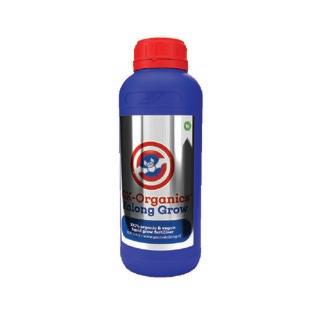

Discover the complete organic liquid range thanks to the new GK-Organics ® Florizon ! 100% organic fertilizers • www.gk-organics.nl distributed by: Check our new feed schedules:
A Place For Connection
Lately, all I’ve been thinking about is disconnection. Or, more clearly, the ideas of connection and disconnection. I started asking myself, “what’s the difference between being disconnected from the wider world through the web and being disconnected from the world of nature and people?”
A Loaded Question
This question hit the mark and gave me lots to think about constructively. I started to see the differences. I was first struck by how similarly we phrase it. The word “connection” makes us feel satisfied, for sure. Still, I began to see the idea of connecting through social media and the web as not being a connection at all, just more the concept of connection or interaction. We touch our phones and feel close to this thing that holds our “connection” to the broader world.
Finding True Connection
The other day, I went for a long walk alone at 6 am. I don’t get to do that very often as I have a one-year-old with whom I spend a lot of time. I started heading uphill and was finding my stride, head full of thoughts and ideas, feeling a bit stressed out. But I knew that walking and the outdoors would work for me, or with me. Then I started to slow down and experience where I was. I felt immensely grateful for the place I live and its beauty.
“This is connection”, I thought to myself. Call it appreciation or acknowledgement, something undeniably real was happening for me through a physical reaction to the landscape. On some level, I connected with the land; on a more subtle level, the landscape connected with me. It can’t just be one way, can it? So when I started to appreciate what’s there for me whenever I want it, it doubled my feeling of connection and acknowledgement. I was connecting to the wider world – that was what was happening.
Online vs Real Life
Now to bring it back to an online connection, there’s nothing expansive or mysterious about it. I put something out there, and I get a reaction. I feel okay, or I feel disappointed. It just doesn’t feel satisfying at all. Is that a real connection? Being with the natural world feels effortless; I’m not putting any work into it. All I have to do is be open, and a world of feelings and senses opens up to me. I’m distracting myself, not with a screen and ideas and thinking, but with natural shapes, sounds, smells and feelings that I’ve grown from as a human. It feels like the world wants me to connect. I’ve always had that feeling, but now it’s much stronger.
In this multi-part series, Alan Creedon writes about his decision to close his social media accounts and focus on creating real-life connections. If you missed the first articles of Alan’s series, find them in our digital magazines at GCMag.co
Hindsight Is 20/20
In truth, the amount of disconnection I felt through spending time on social media and its resultant thinking loops left me shocked. I thought I was already connected, but now I see that the distraction and disconnection of web-based stuff are bad for my health on quite a deep level. And it was so subtle I hardly noticed it was happening, or at least I justified it as good because it was helping me with my business and keeping my finger on the pulse. Having had some time away from the checking and the socials, I now see that it was all slowly making me feel miserable and disconnected, but I could not see that from within.
So, connection or connection? What’ll it be?
Seriously consider the above question. Have you been longing to reconnect with Nature and leave the gadgets behind? Alan continues to build on his journey of disconnection and finding true connection in the next instalment of his series. 3
BIO Alan has worked in local food for over a decade and in that time has been involved in retail, wholesale and growing local produce. He is passionate about people working together and enjoys bringing his ideas into the world of veg. He lives in the West Yorkshire hills with his wife, daughter, son, dog and cat and loves walking in the hills, sleeping out in the woods, and having a dip in the river (but would sometimes prefer sleeping out in -3 than a dip in the river!). He will be publishing his first book this autumn. He is a mindfulness teacher, running regular courses and events as a nature connection guide. He likes to combine the philosophical with the practical.

BY ALAN CREEDON
85
85
DITCHING SOCIAL MEDIA
“This is connection”, I thought to myself.




Visit GardenCultureMagazine.com and subscribe now! Don’t want to miss out? Grow your own – no matter where you live. Sustainable, efficient gardening. New hints and tips Follow Us GardenCulture GardenCulture Garden_Culture GardenCultureMagazine 10 years, and grow ingstro n g ! Don’t want to miss out?
I love your products!!!
I noticed a difference right away
love this stuff!
The optic foliar line actually works! I noticed a visible difference in my plants within 2 days. I highly recommend this product.


great!!
Saw results after first use no BS. just give it a try
10X easier
Your products make my routine 10x easier being able to spray with LIGHTS ON!
It really works!
THIS SPRAY REALLY WORKS.!!!! Will buy again
No Damage No Burning No Residuals Ready To Use & Concentrate
spray.
Over 22 year experience providing guaranteed foliar spray solutions SALES@OPTICFOLIAR.COM 01949 839 727
Original the Lights on
Also flower safe!!!
Passive Solar Geothermal Greenhouse at the 45th Parallel
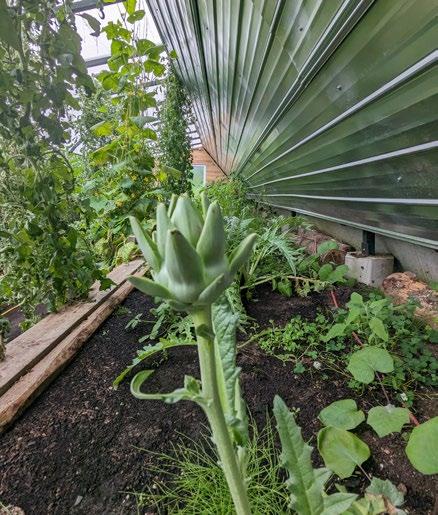


TEXT AND PHOTOS BY MARCI BABINEAU
88
Last August, we were screwing down the 14’x3’ sheets of double-ply PVC to the metal frame of the 60-foot greenhouse we were building on the mountainside. It was pouring rain. Once we’d finished screwing down the last sheet, we stood dripping inside the cocooned greenhouse listening to the pounding clatter. Standing on the sunken floor below the new roof, we felt we might finish building it before the snow came.
Extending The Growing Season
We had decided, for better or worse, to build a Greenhouse in the Snow Canada greenhouse last summer. Russ Finch, a retired-postal-worker-turned-market-gardener, engineered it for growing citrus in Nebraska. We were interested in a nine-month growing season. I had written to Russ a few years hence, asking if they shipped to Canada. It seemed complicated. But some folks in BC bought a franchise, and buying it became easier.
Breaking Ground
The construction began in late April 2022. Our neighbour Eric and his Kubota began to dig an 8’x4’x60’ long trench on the upper terrace of our hillside, just south of the butternut orchard. Because our orchards are planted on the mountainous terraces of the Canadian Shield, we were immediately treated to some huge rocks that the Kubota could barely strain from the earth. We had been encouraged to do an engineering site assessment by our friends in BC. Naively, I imagined it to be a technicality. It couldn’t have possibly articulated the boulder count. Over the following weeks, Eric continued digging a circular trench that was 10 feet deep and 250 feet long for the geothermal tubes. Ultimately, he had extracted enough large rocks to build the two terraces that secure the greenhouse to the mountainside.
After digging the greenhouse footprint and the trench, they began to fill with water. The words “engineering assessment” rang in my ears. However, it occurred to us that we might be able to drain the greenhouse into some wells at the west end.
We dug these as deeply as possible. The two well cylinders sit on a large rock sheet that runs the entire terrace’s width. This geologic wonder means that much of the water from the mountainside passes through the wells (and sometimes into the overflow). They have enabled us to water from inside the greenhouse the entire growing season.
At this point, there was still a lot of work to do, including:
• Digging and placing the footings;
• Building retaining walls for the front and back inside beds;
• Installing the metal super-structure, the north-facing insulated metal wall, and the south-facing PVC;
• Creating the back and front rock and soil berms;
• Building the east and west ends;
• Filling the beds with compost;
• Installing the blower for the geothermal system.
Planting
By September, I’d planted 100 experimental tomato plants on the greenhouse floor. With the two ends open, it was a brute of a hoop house with no airflow concerns. The tomatoes grew

like savages. I transplanted some artichokes to overwinter and began seeding greens. A ginger plant that had lived in a pot for 12 years was planted inside. A friend asked me to overwinter her fig trees.
Hot House
Once the ends were built in late September, we began to experience the intense heat-up when the sun shone. The thermometers would bounce to 50°C unless we left the door and windows at the ends open. The tomatoes stressed, and the ginger jumped. But, by mid-October, the sun had fallen so low along the horizon that it was only hitting the back bed directly. The nights were cold, and I still had not assembled and installed the blower. These conditions did not make a happy tomato! They packed it in by mid-November, and the green tomatoes came down to the house for ripening.
Low-Tech, High Yield
The plan was to keep the winter growing as low-tech as possible: no heating or grow lights. The ginger, figs and artichokes would have to tough it out. And they did, though the figs were less than impressed.
89
By mid-April, the Mediterranean friends could be seeded: tomatoes, peppers, eggplant, and basil, with cucumbers and luffa representing the cucurbits and okra of the African subcontinent
89 GEOTHERMAL GREENHOUSE









@thesourcefertiliser root stimulator grow stimulator flower stimulator PK stimulator boost stimulator CalMag stimulator plus sourcefertiliser.com Now available in 250ml, 1L, and 5L Go to the source, for plant nutrition in its purest form. It’s a simple concept. Clean, highly concentrated fertilisers for effective, efficient performance. s urce the made in the U.K. Works in harmony with AutoPot Watering Systems and all other cultivation methods.
The idea of passive geothermal is that the air temperature ten feet down maintains a steady state of 15°C. Blowing that air through the tubes should bring up the temperature in the greenhouse when it is -20°C or -30°C outside. They suggested that the slower air movement through the tubes would heat it better, but the airflow was undetectable with the blower on the lower setting. The plan remains to rewire it to medium this winter.
An Early Start
This year, I got started in the greenhouse in March. Deep snow was all around. Despite the overcast spring, cabbage, peas and kohlrabi seeds sprouted by the beginning of April. The greens that had muscled through the winter were properly thinned. Once the cabbages were up, I felt invincible, so I went on and planted my flowers, including marigolds, sunflowers and calendula. Everything could be planted directly into the beds, then transplanted into pots to establish individual root systems and harden off.
By mid-April, the Mediterranean friends could be seeded: tomatoes, peppers, eggplant, and basil, with cucumbers and luffa representing the cucurbits and okra of the African subcontinent. As I moved the flowers, cabbage and greens to pots, I moved the heat lovers into their summer homes. I had so much success with the tomato seeds-to-plants that I had a surplus to donate to the local elementary school. Next spring, I will prepare for a neighbourhood plant sale.
My biggest first-year greenhouse growing takeaways were:




1. Seed germination times were not earlier in the season but took less time and grew faster.
2. The angle of the winter sun was the biggest impediment to winter growing.
3. Plant fewer plants. A single greenhouse plant will have three or four times the output of a plant living outside in similar conditions. For instance, I planted the cucumbers in regular spacing. I placed the little plants behind two 4-foottall slanted trellises. Within a month, they had topped the trellises and had begun to latch onto the training strings of the two nearby tomatoes. In mid-July, one of the groups of cucumber vines collapsed under its weight. The excessive vines had shaded its produce so that the fruit withered and the harvest was greatly reduced.
4. Interplanting is not a winner. Airflow must be respected. It would be cool to grow watermelon and cantaloupe on the floors of the beds (beneath the tomatoes and peppers) to maximise production. But soon, these vines were growing up and over everything, then mildewing, so they had to be added to the compost pile.
It Was Worth It All
Last summer, I spent considerable time wondering why I had dragged my family into such building shenanigans for a bit of veg. This summer, I can hardly imagine growing many things we like to eat without the greenhouse. It will be years before it is more than a happy experiment, but fingers crossed for lemons in 2024! 3
BIO Marci Babineau grew up in gardens in California and Georgia. She currently gardens north of Montreal, Quebec, where she has nestled a food forest into a south facing hillside. Working in organic gardening and landscaping for 40 years, she has written about and taught a variety of gardening topics to young and old in Montreal and Cambridge, UK.
9191 91 GEOTHERMAL GREENHOUSE
The idea of passive geothermal is that the air temperature ten feet down maintains a steady state of 15°C
A single greenhouse plant will have three or four times the output of a plant living outside in similar conditions
Local Growers

WHO’S GROWING WHAT WHERE
Isis Carrasco
Hebden Bridge
As for many people trying to navigate life stresses, allotment therapy comes to the rescue. Isis Carrasco is my current allotment neighbour, and the view of her perfect plot always puts mine to shame.


Under mounting job pressures, Isis found herself seeking some solace. A friend’s suggestion led her to get an allotment. The initial sight was disheartening: an unimaginative plot of land overrun by weeds, broken glass, and stones. On the plus side, it was bordered by beautiful oak woods. Despite lacking prior landscaping or gardening experience, she took on the challenge. That decision proved life-changing; eight years later, one would think she’s an experienced garden designer.
The space transformed remarkably with time, blending elements of an allotment and a garden. It became a place for various crops, changing yearly with new additions of beautiful rockery plants, annuals, perennials and fruit trees. She grows flowers, corn, pumpkins, beans, courgettes, tomatoes, and potatoes. Each season brings the joy of experimenting with new and often unique crops, like the current challenge of growing celeriac. Isis says, “Tasting my home-grown vegetables and knowing I played a part in their journey from soil to plate rewards me immensely.”
Isis always welcomes the small allotment community to her plot, whether for a quick catch-up or a summer barbecue. Last year, Isis created a stunning pot-style cottage garden around the summerhouse, complete with a wildlife pond and a small patch of grass for her lovely dog, Lola. The summerhouse features a kitchenette where she enjoys an evening glass of wine with friends and other plot-holders.
The journey has sparked another change in her life – a career change. The connection to responsibly grown and quality food made her leave behind her role in voluntary sector management,

in the UK & Ireland


and she joined Suma Wholefoods, a worker’s co-op specialising in organic and fair-trade food. Here, the values of ethical food production and worker rights aligned with her own.
Tending to her plot became a rewarding exercise in patience and diligence. It ignited her creative spark and instilled a profound sense of accomplishment that no other hobby can match. I love having her smiley face there whenever I rush around the plot. I enjoy chatting with her over the fence and, of course, an occasional summer evening beer.
BY
92
MARTYNA KROL
Would you like to be featured as one of our local growers? If you’ve got a garden, grow room, or farm and have a story to share, contact us at: growers@gardenculturemagazine.com




Anjee Harrison
Lancashire

Meet Anjee, an avid allotment lover and family gardener. Her interest in growing edibles started when she was a small child. As a teenager, she and her dad created a veggie patch. But the real passion began when she applied for an allotment. It took five years of being on a waiting list, but eventually, she became the proud custodian of Plot26a! The timing wasn’t great, as with four children under six years old (the youngest only two weeks old at the time!) and a non-gardening husband who worked away, sorting the allotment seemed a hell of a task, but nothing deters her!
Over the years, Anjee’s allotment has developed from a mud pie factory to a space where the family grows food and makes many memories together. During lockdown, they became more selfreliant by creating another small veg patch at home and keeping chickens.
Through the years, the experience of growing so many different plants has brought new methods and species to try. Anjee’s preference leans toward perennial edibles, and while her collection expands year by year, Taunton Deane remains her absolute favourite. Anjee discovered the benefits of no-dig gardening and the joy of making the veggie garden an inviting and attractive place for wildlife by creating new habitats and pollinator-friendly flowers. The space evolves yearly, and the whole family constantly learns from it. You can track their growth journey on Instagram, and Anjee’s enthusiasm for family allotment gardening is now accessible through her YouTube channel, ‘From Anjee’s Garden’.
Sharing the love of growing and the wonder of nature with the next generation is hugely important to her, as she benefited so much from it in her own life. She runs a forest school and gardening sessions with the home education community where everyone engages in fun outdoor learning, foraging, growing food and visiting inspirational places. She hosts many gardening talks and workshops and sells plants, seeds, and skincare products crafted from flowers and medicinal plants harvested from her garden. You can find her beautiful creations and learn more about her at:
From Anjee’s Garden
@plot26a
@fromanjeesgarden

93 WHAT’S GROWING ON GARDENCULTUREMAGAZINE.COM
FAST. RESPONSIVE. BESPOKE.
WEB DESIGN

Designer A person who takes a problem and creates a solution.
Developer Takes a design solution and builds a web experience. Business Is what comes to those who sell an experience.


WWW.NPK.MEDIA @NPK_MEDIA









mamapublishing.com | cannascope.com
available in ebooks
Pioneering References Also
WAYS To Light Up Your Indoor Growing Space



Light Up
Let there be light! It’s no secret that plants need sunlight for photosynthesis, which isn’t always evident when growing indoors. With cooler months ahead in many parts of the world, we are turning our plant-loving energy to grow rooms, windowsills, and countertops. Room illumination is critical to the success of a plant, whether it be edible or ornamental. As we transition from the great outdoors to the inside of our homes, offer your plants the best with our 5 Cool Ways To Light Up Your Indoor Growing Space.
Choose Windows Wisely
If you’re fortunate enough to have many windows in your home, select your growing space wisely. Avoid placing plants in windows with large trees or shrubs blocking sunlight from entering. Lisa Eldred Steinkopf, author of Grow In The Dark: How To Choose and Care for Low-Light Houseplants, recommends keeping the direction the window faces in mind as well. Many plants love east windows because they get soft, cool light first thing in the morning. She says African violets, ferns, and begonias will love an east-facing placement. West windows offer high heat levels, so cacti, succulents, and snake plants will thrive there. South-facing windows get the most sun throughout the day, so placing plants with high light needs in front of them is best. North windows are always deprived of direct sunlight, so find another option or offer supplemental lighting if it’s your only window. Don’t forget about skylights! Eldred Steinkopf refers to them as the fifth exposure and says they’re great for growing a wide variety of heat and light-loving plants.
Cleaning Windows 2
We hate to add more chores to your list, but window cleaning is essential to anyone who loves houseplants or countertop gardens (and a tidy home). Between smog, dirt, rain, your kid’s fingerprints, and the dog’s wet nose, a lot of nastiness builds up on window glass, reducing the light that shines into the house. The fall is an excellent time to give your windows a thorough cleaning, inside and out, especially if moving outdoor plants inside. They’ll need all the light they can get! While at it, wash your screens of all the dust and pollen they’ve collected over the summer. Eldred Steinkopf recommends removing screens in the fall and storing them somewhere throughout the winter. She says screens can block light coming into a home by 30%, even when clean! After you’ve finished cleaning your windows, wipe your plants down too.The dust and pet hair that settles on their leaves means light can’t efficiently reach their cells.

1
Mirror, Mirror on the Wall 3
Do you want to admire yourself and make your space feel larger while illuminating your plants (three for one!)? Hang some mirrors! Many of us underestimate how much light mirrors can add to a room. Placing them across from windows allows houseplants or countertop kitchen gardens to feel warmth and access light from every direction, which helps them avoid phototropism. Plants suffering from phototropism lean directly toward the light source, frequently a window. Adding mirrors to the wall space around them will help them grow symmetrically. While we’re on the subject of walls, we’re not a decor magazine, but lighter paint colours have better reflective qualities and can help illuminate your growing space too.
Reflectors 4
Like hanging mirrors to help reflect light onto your plants, you can also purchase reflectors for your indoor growing needs. Easy to find and affordable, reflectors redirect the light from your source, bouncing it back toward the plants in your space. The result is more intense and concentrated lighting. Reflectors are ideal if you’re growing high-value plant varieties that need a lot of light and warmth, like orchids, tomatoes, or eggplants. Better yet, if needed, you can position the reflectors to concentrate the light on only one or two plants. They work especially well in grow tents and


LEDs for the Win 5
If you want to boost your indoor growing game, invest in goodquality LEDs for your space. LED lighting is a top seller in many grow shops because they’re heat, so they can be placed very close to the plant canopy. They deliver PAR directly to plants and have excellent PPF and PPFD levels. With their long lifespan and the fact that they’re easy to customise according to your plant’s needs, LED lighting is a must for serious growers looking for excellent yields from their indoor garden. Of course, LEDs may not be the best decor choice for your living room. If you have plants with lower lighting needs, placing them under a simple table lamp might give them all the illumination they need to thrive and brighten the room.



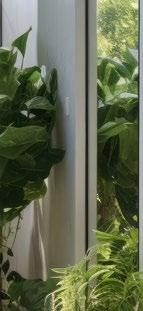
GREEN ADVICE


AdvancedNutrients.com
FIXING EVERY PROBLEM YOU HAD LEFT

















INTRODUCING 2 NEW PRODUCTS
























Promotes root growth and boosts resistance










Increases amount of buds and accelerates flowering



































































No more flakes, foam or biofilm!

No more clogged watering systems!

No more stinky smelling nutrient water!

IN A
At CANNA we love to spend our time conducting research and producing the best quality in everything that we do, whether it be our products, our plants or even our posts! The same applies to this advert. Scan the QR code and check out the Behind The Scenes footage of this advert creation.



















































 Wilma Small Wide 8 11L
Wilma Small Wide 8 11l
Wilma XXL 5 25L
Wilma Large 4 11L
Wilma Large 4 18L
Wilma XXL 8 18L
Wilma XXL16 11L
Wilma Mini 8 1.65L
Wilma XXL 20 6.5L
Wilma XL 4 25L
Wilma Small Wide 8 11L
Wilma Small Wide 8 11l
Wilma XXL 5 25L
Wilma Large 4 11L
Wilma Large 4 18L
Wilma XXL 8 18L
Wilma XXL16 11L
Wilma Mini 8 1.65L
Wilma XXL 20 6.5L
Wilma XL 4 25L































































































































































 BY ADAM CLARKE
BY ADAM CLARKE





















































































































































































































































